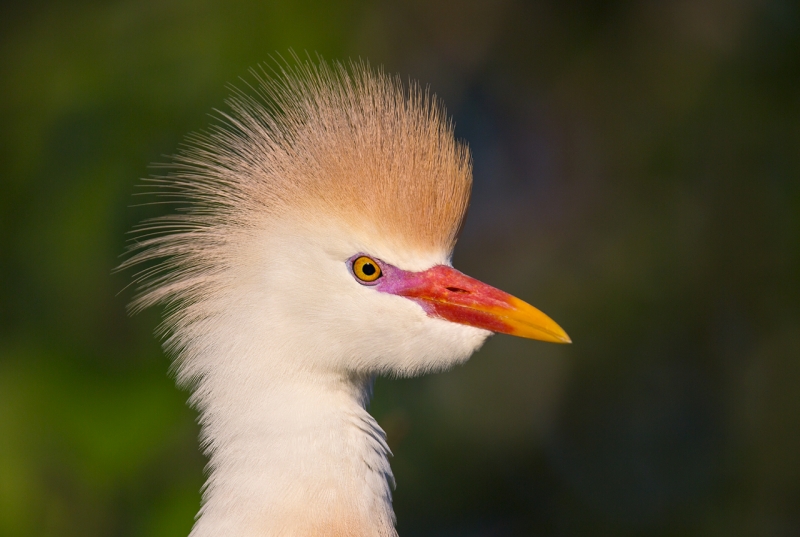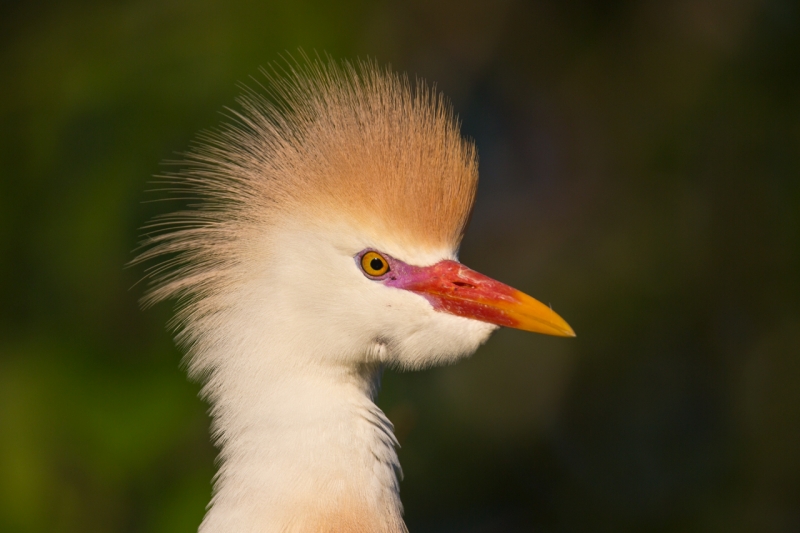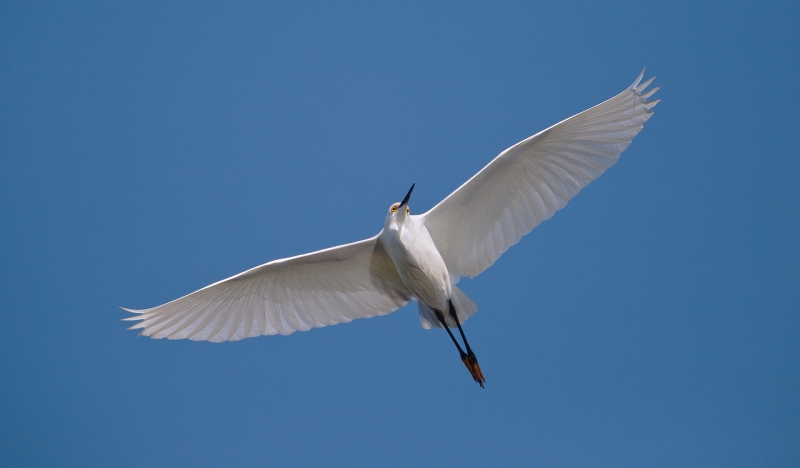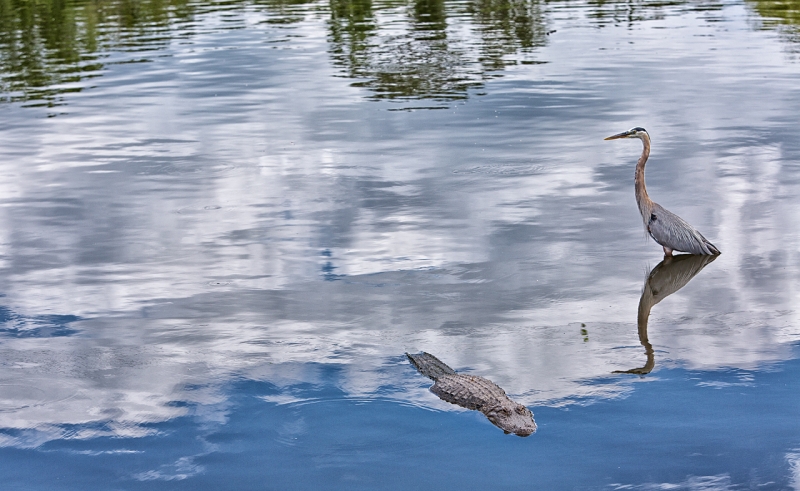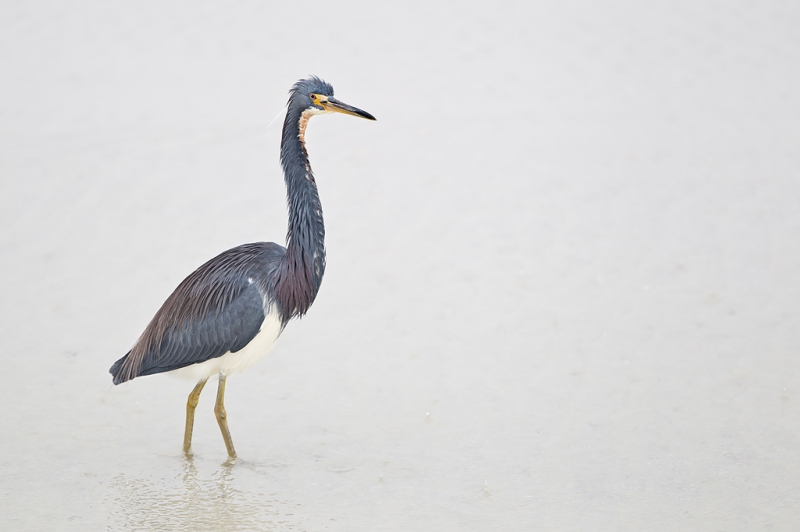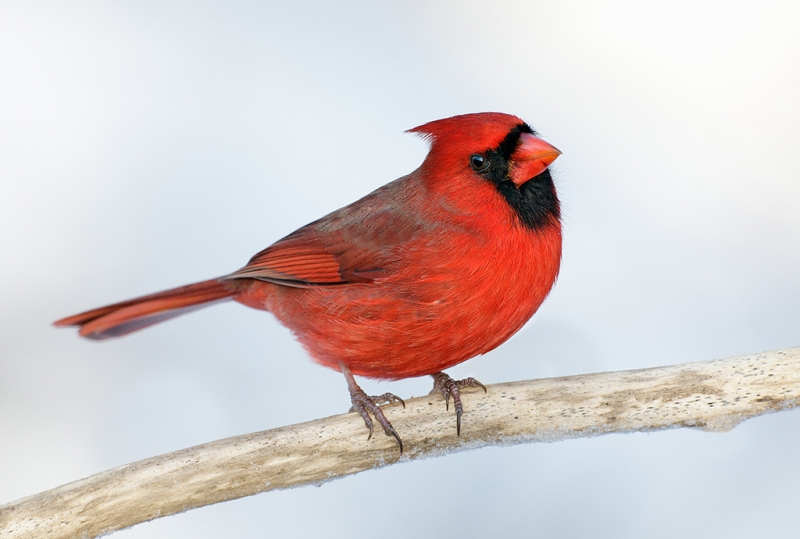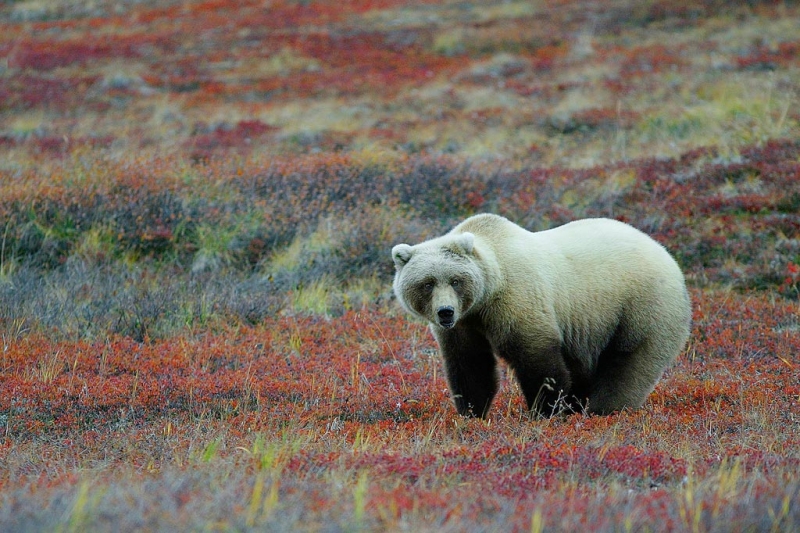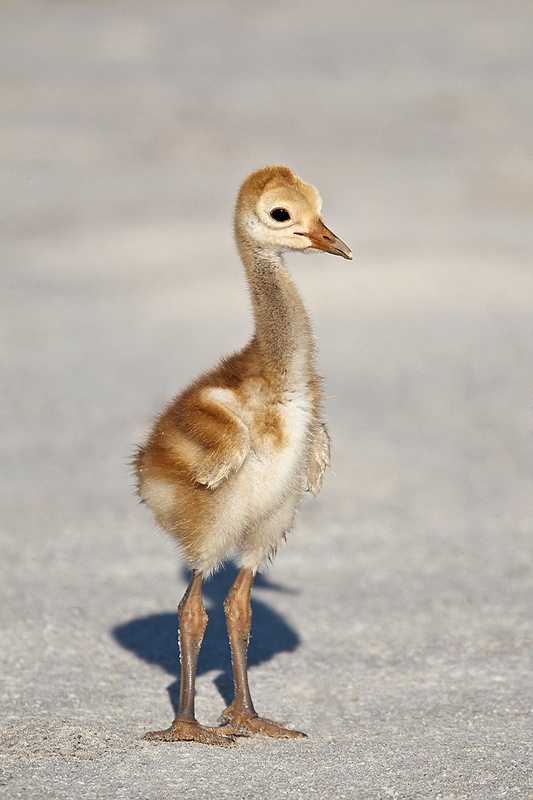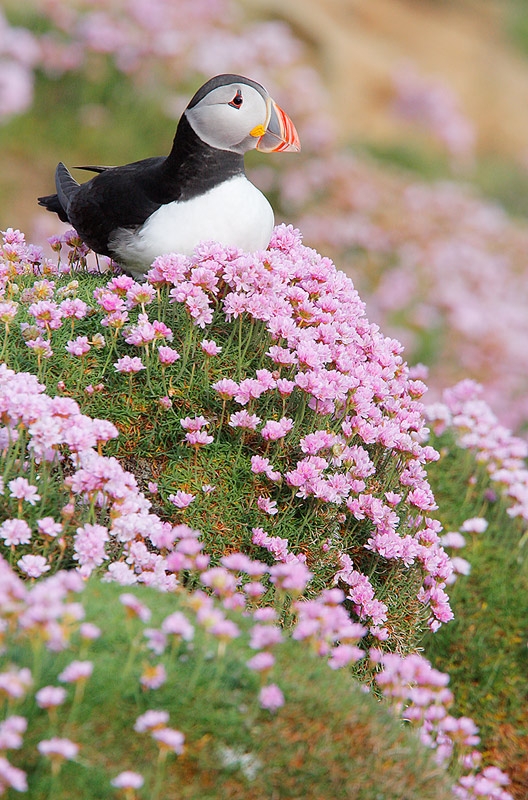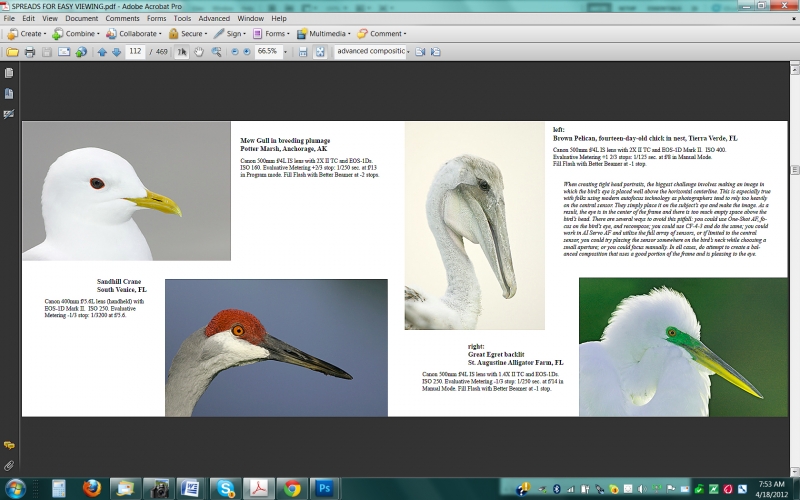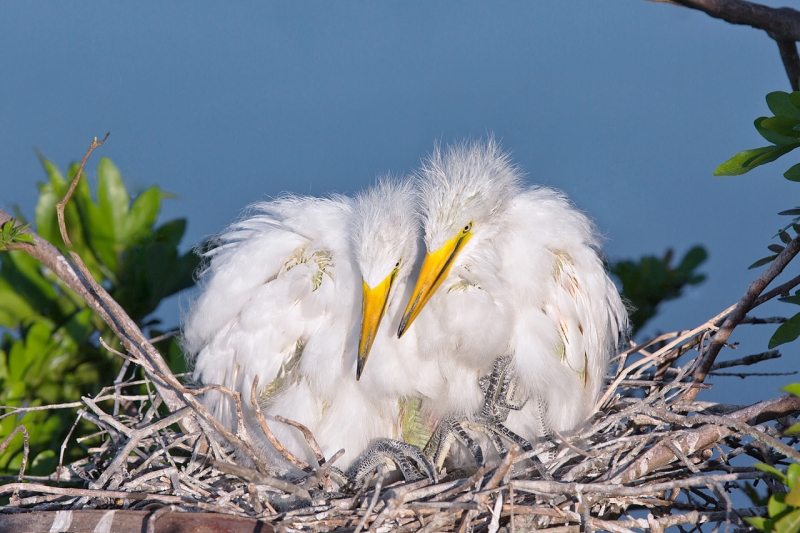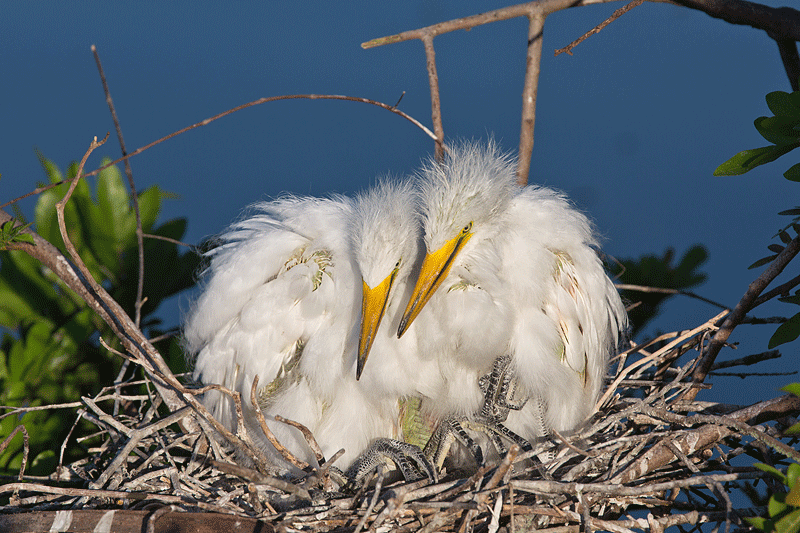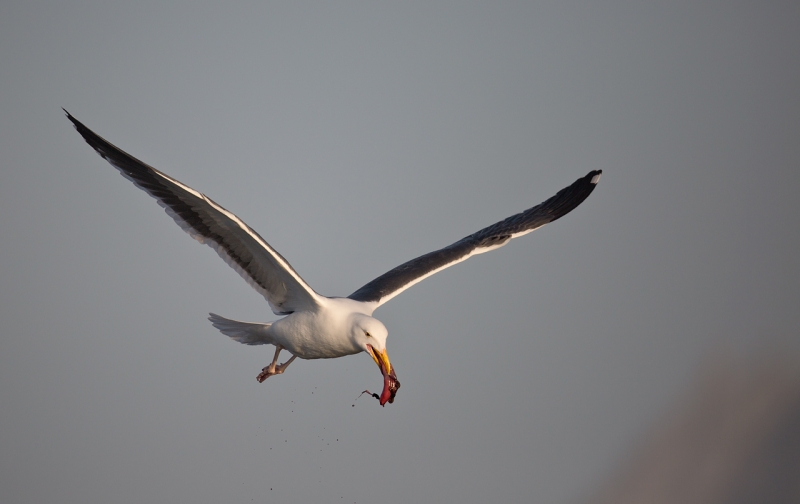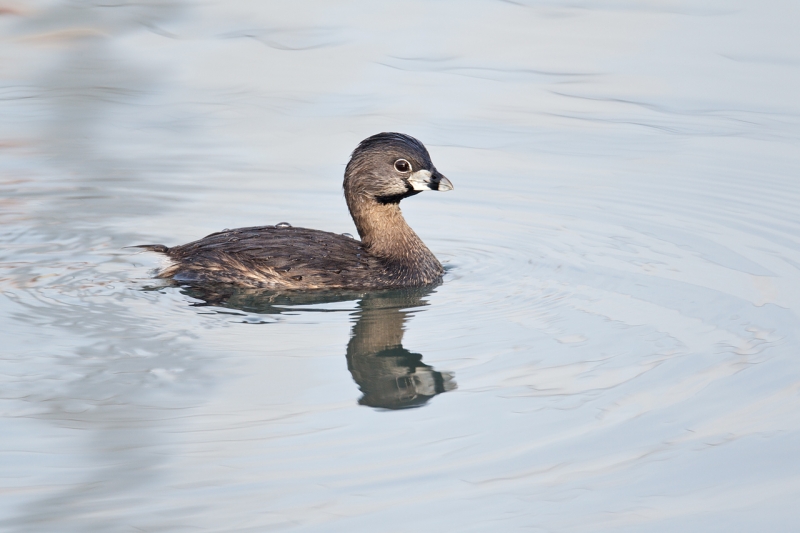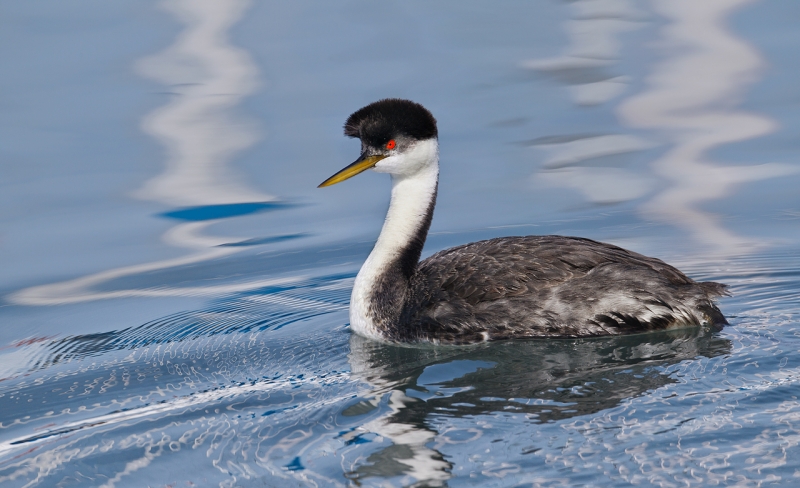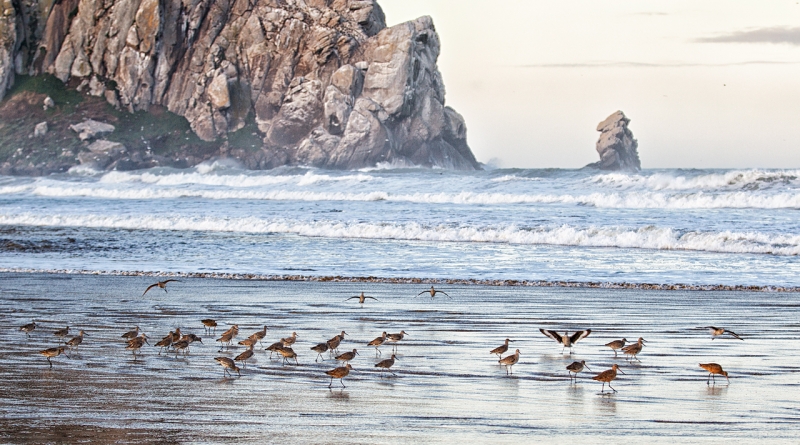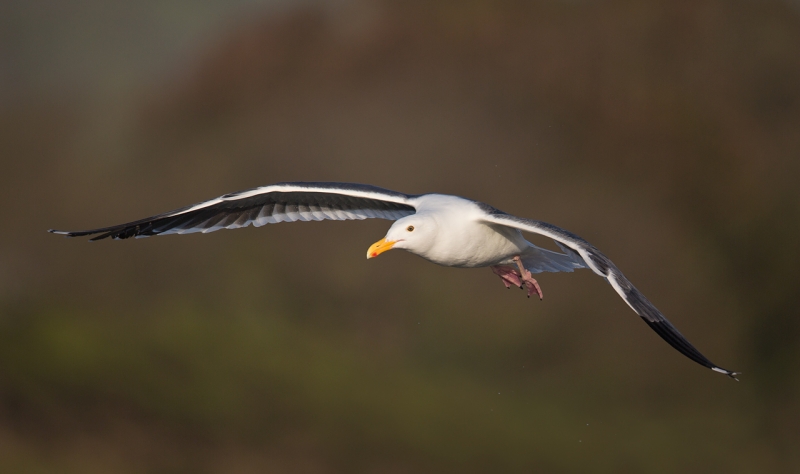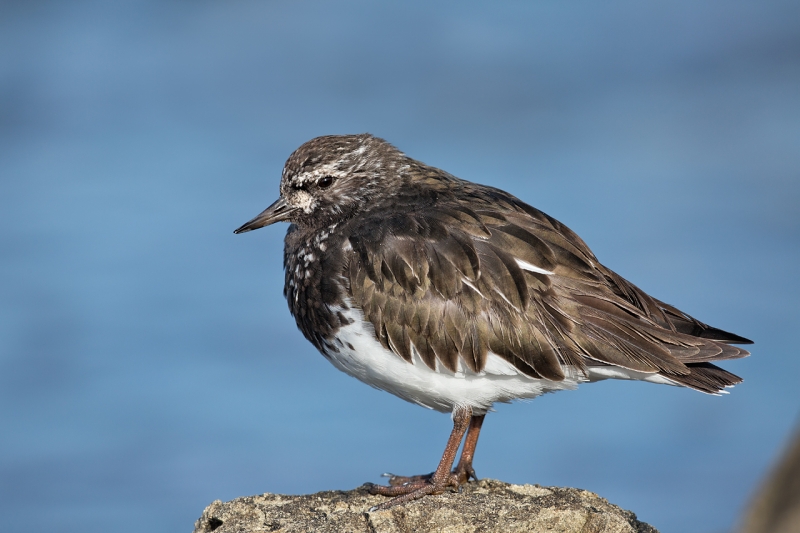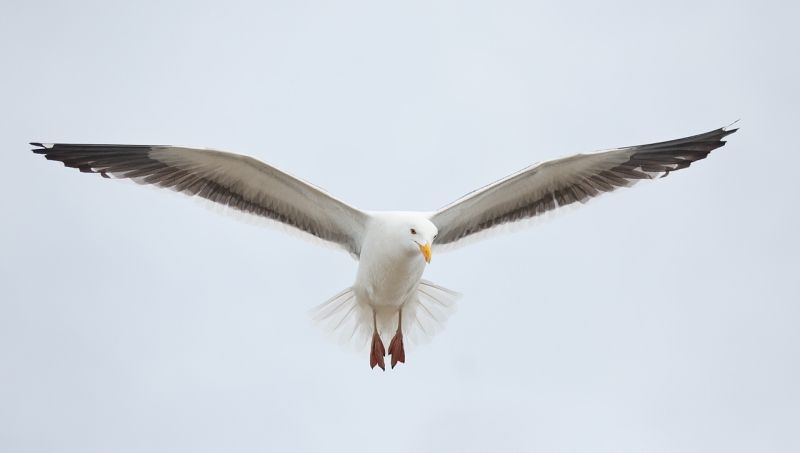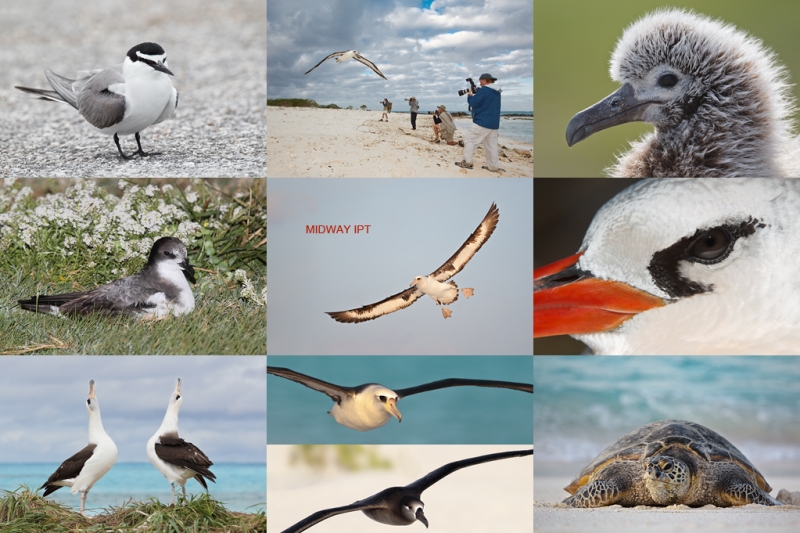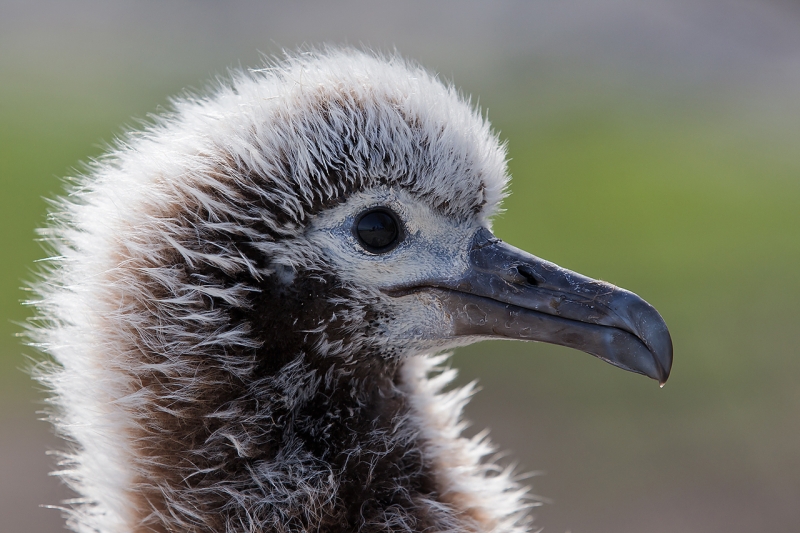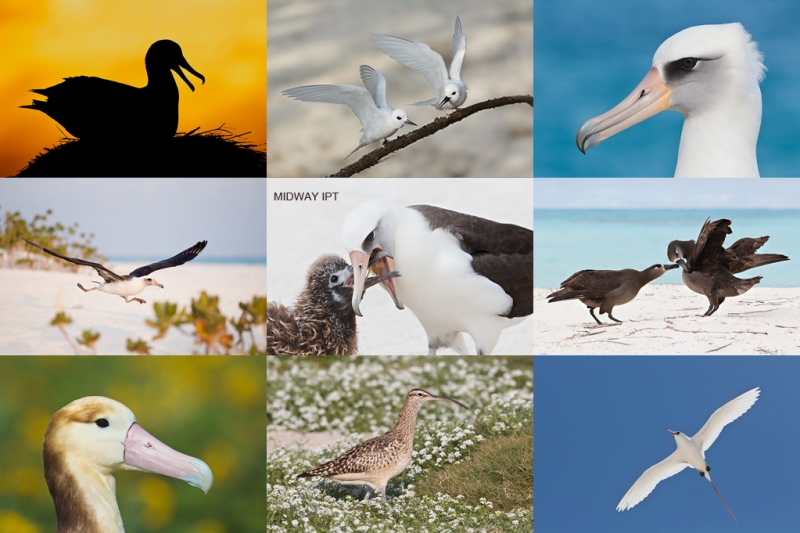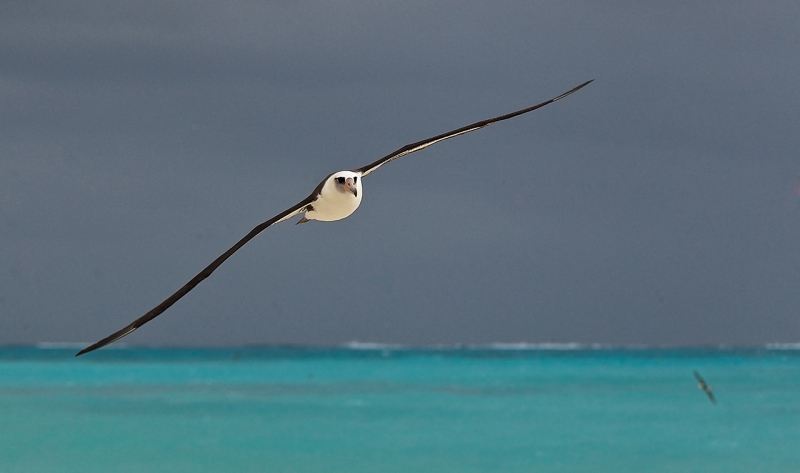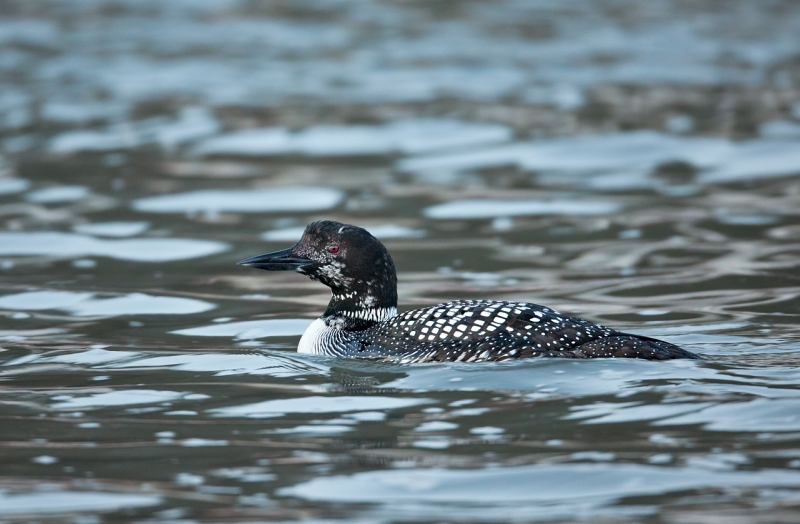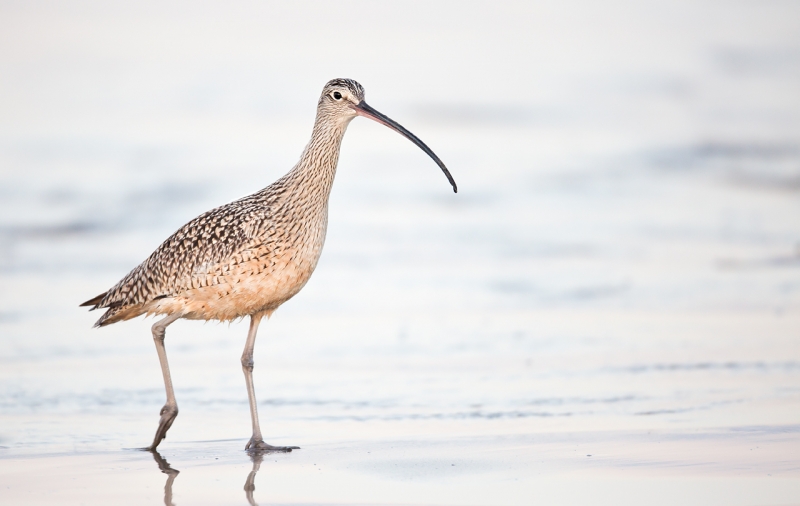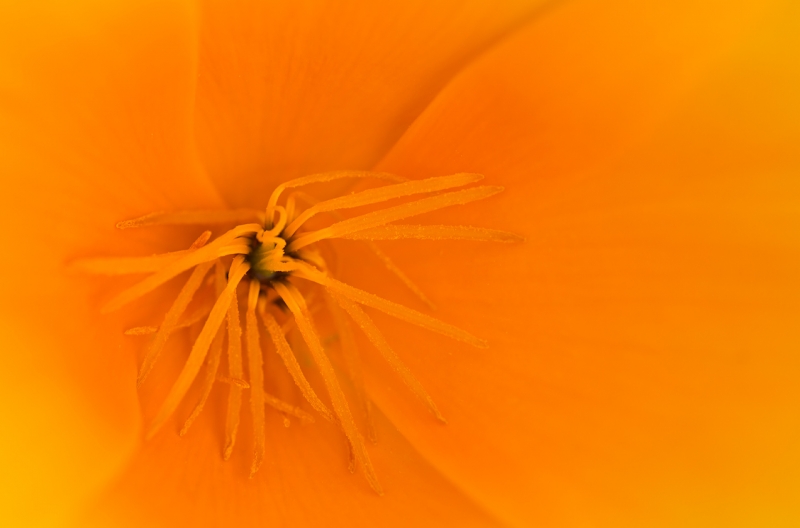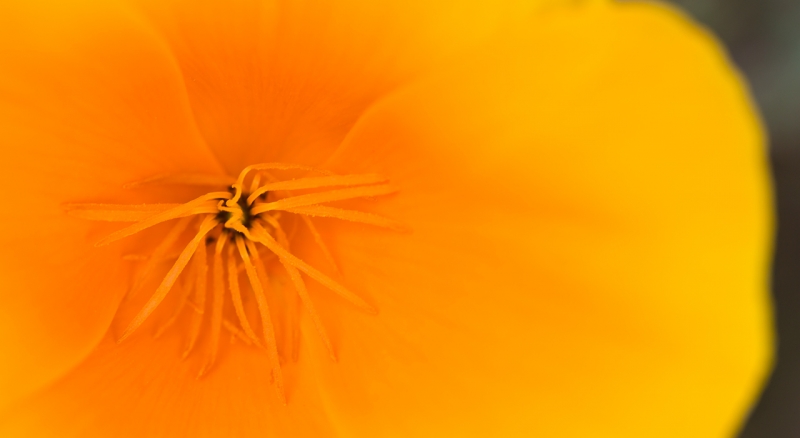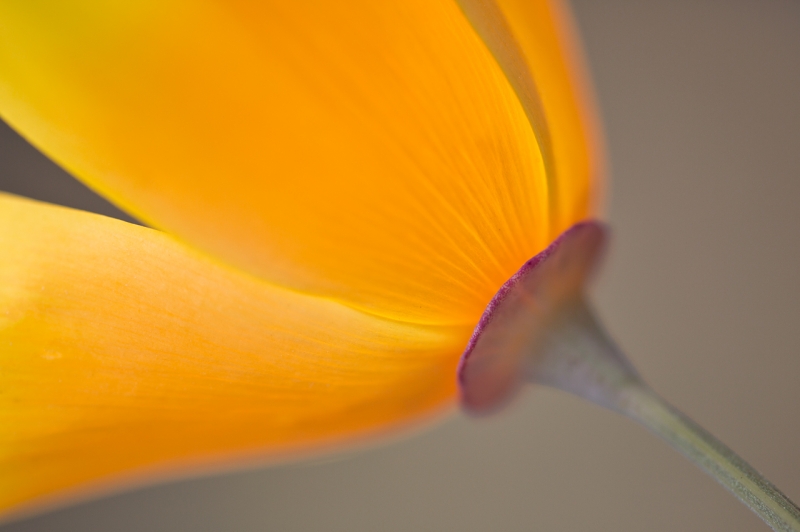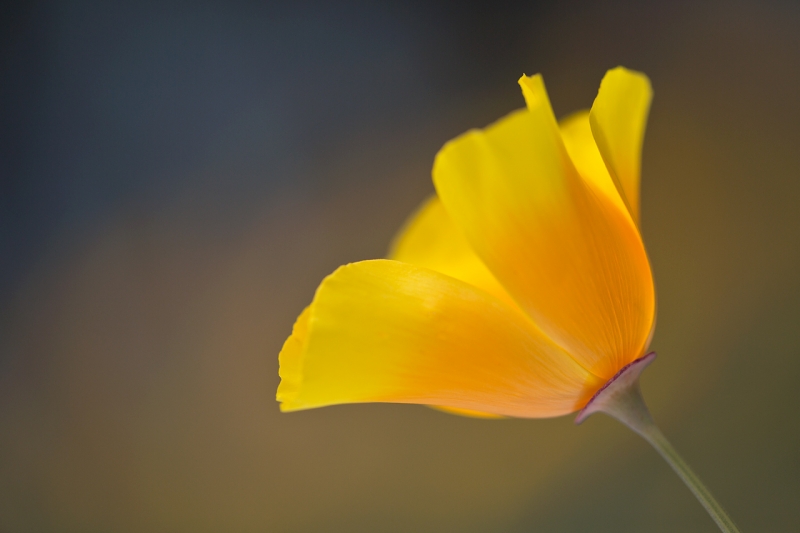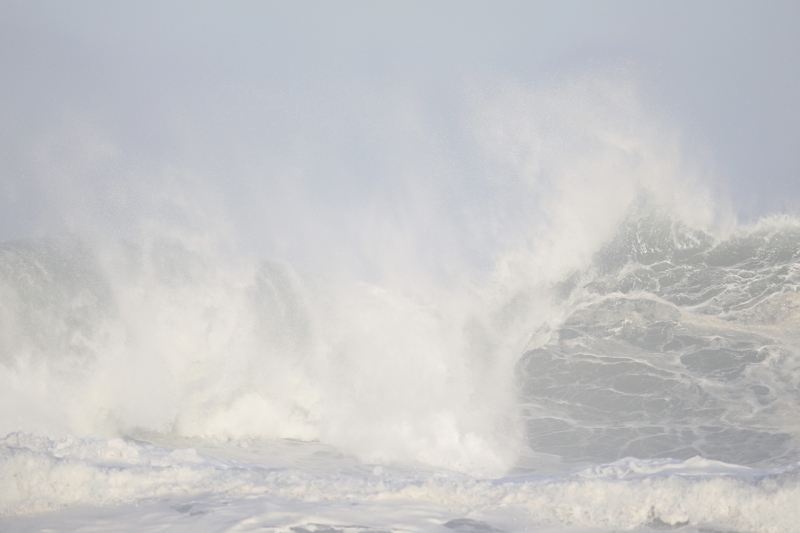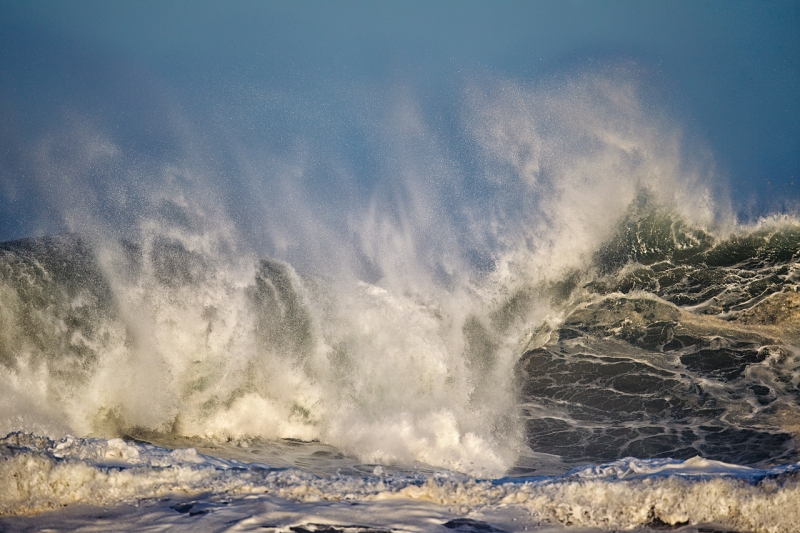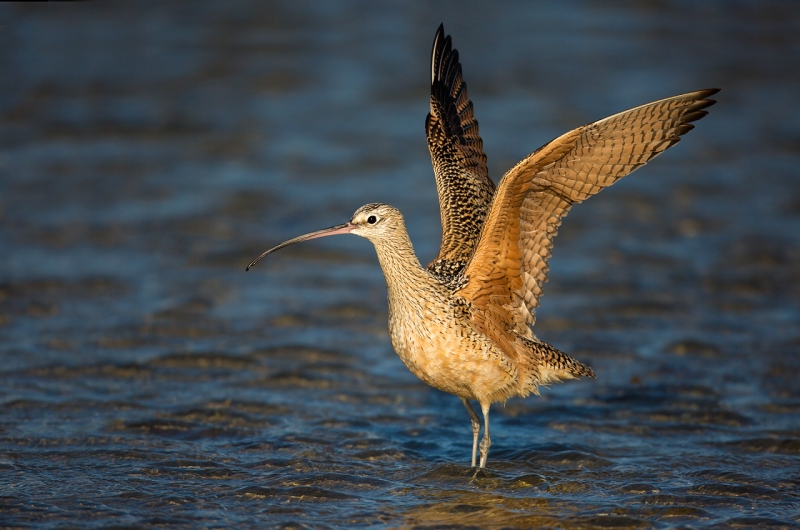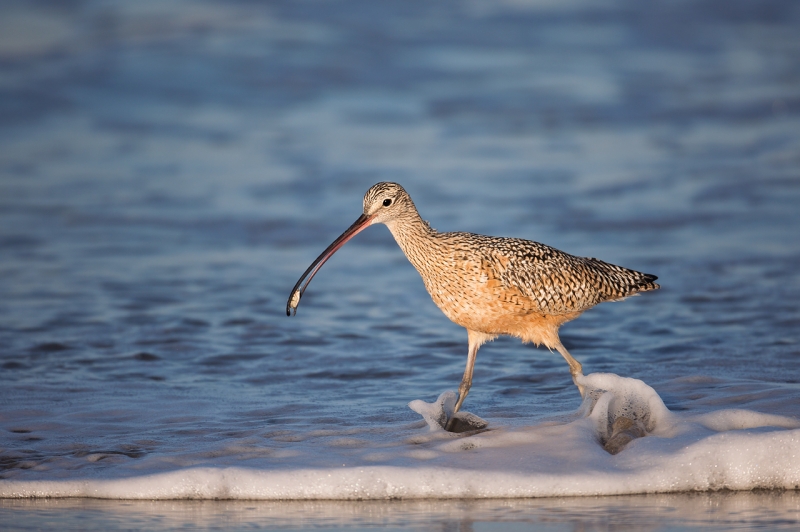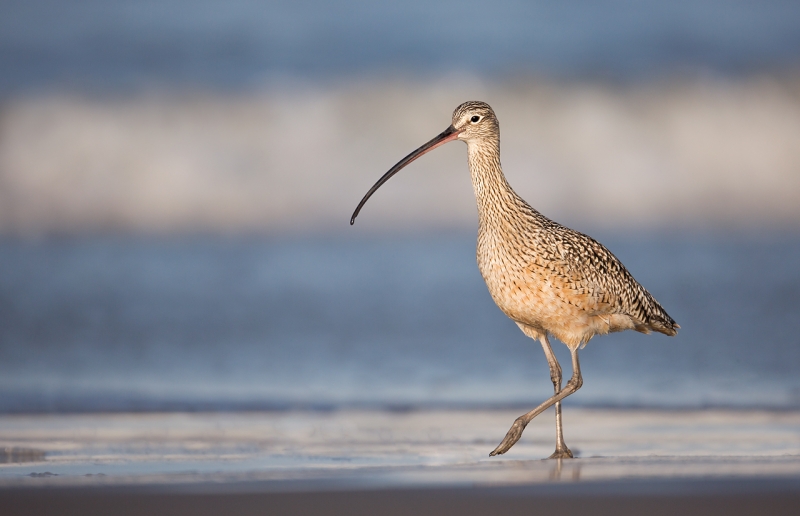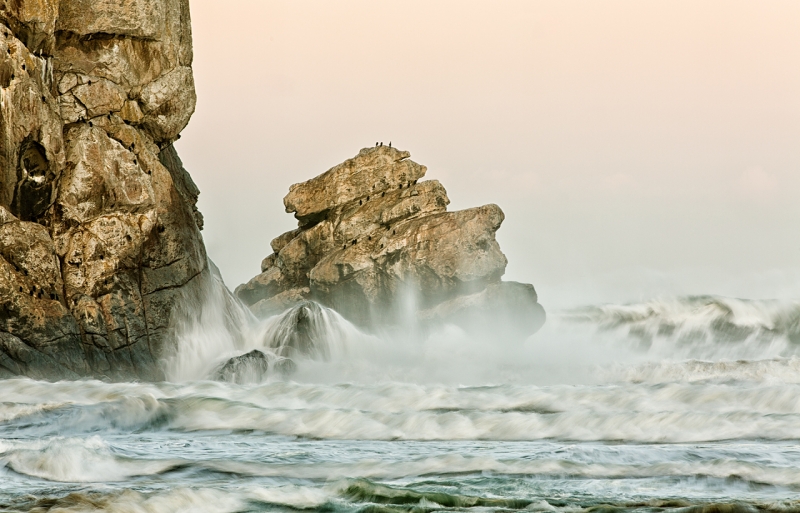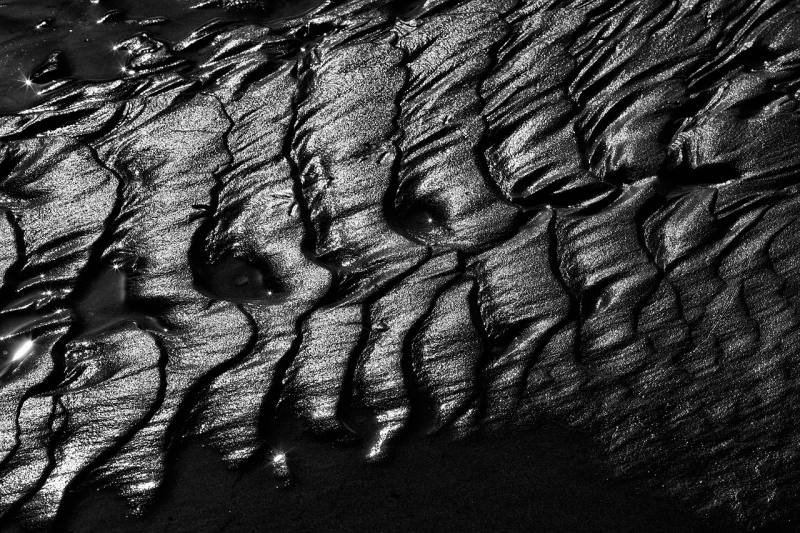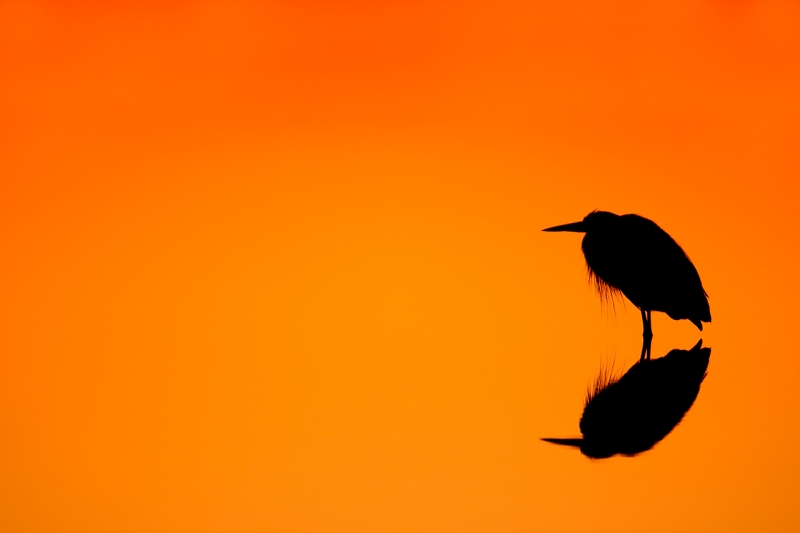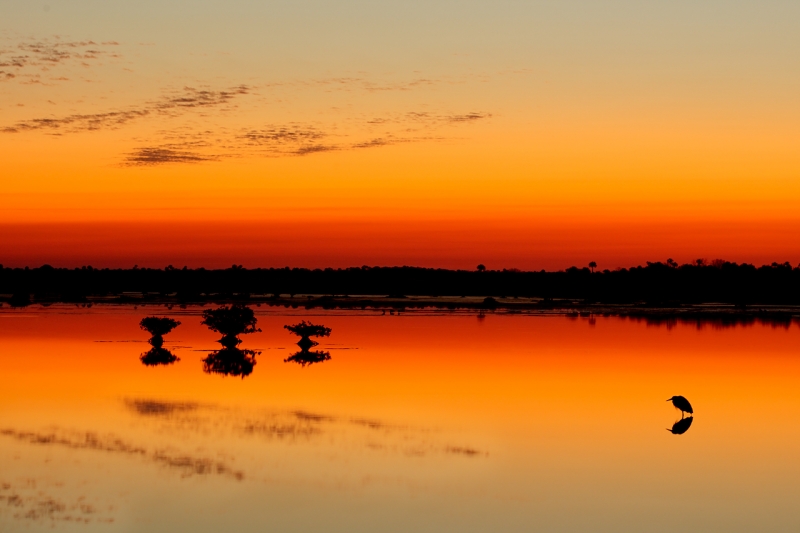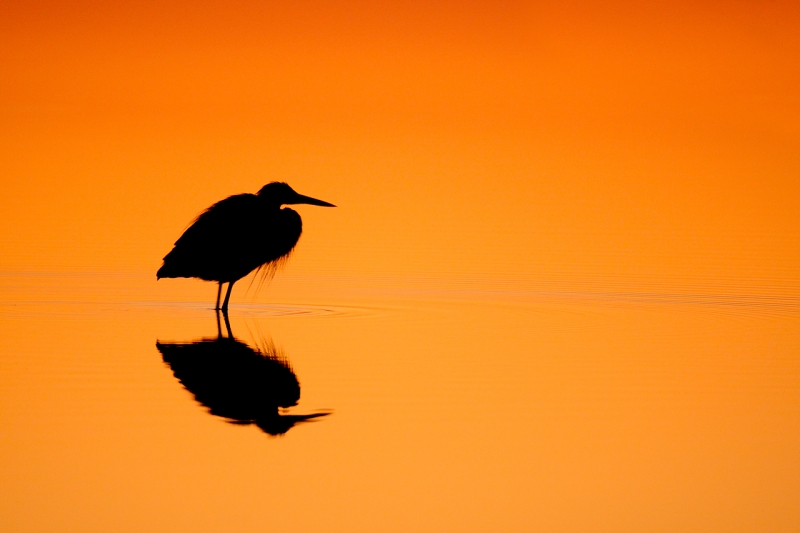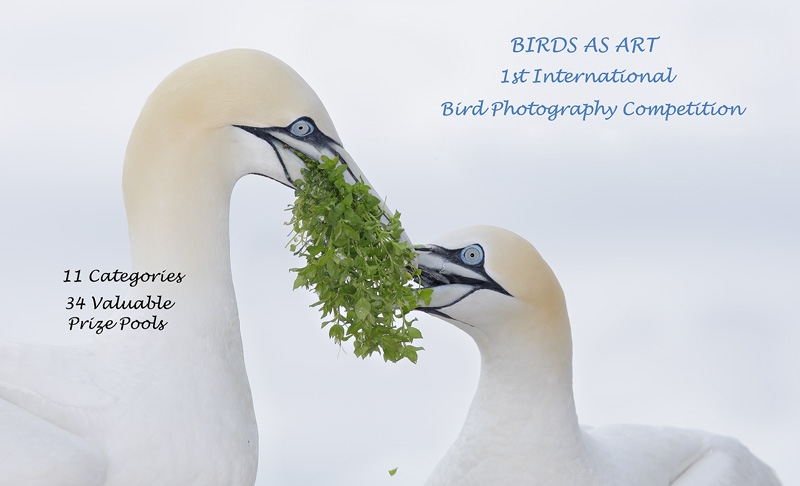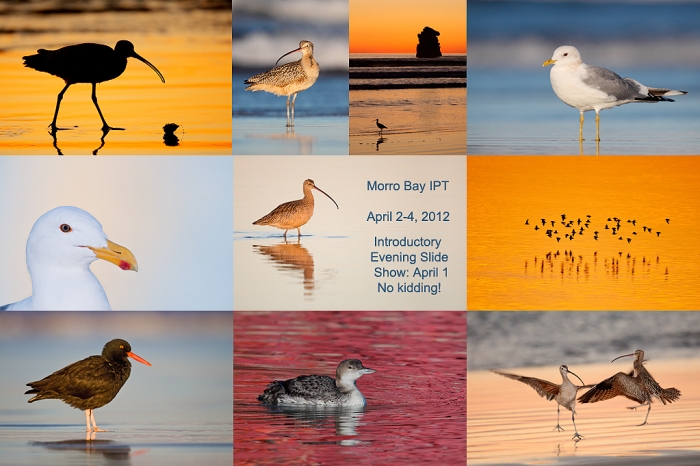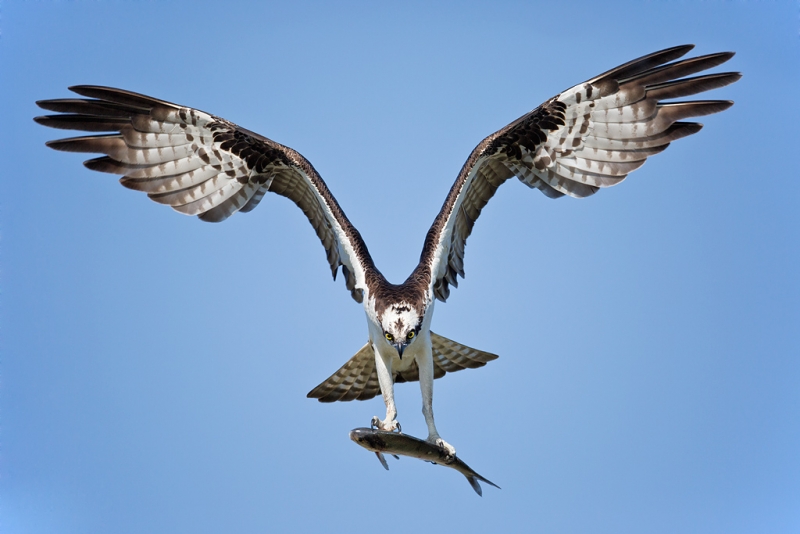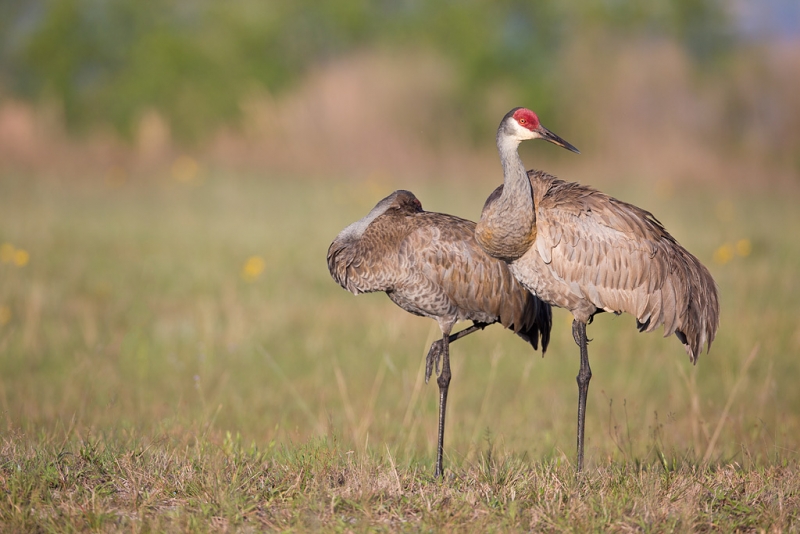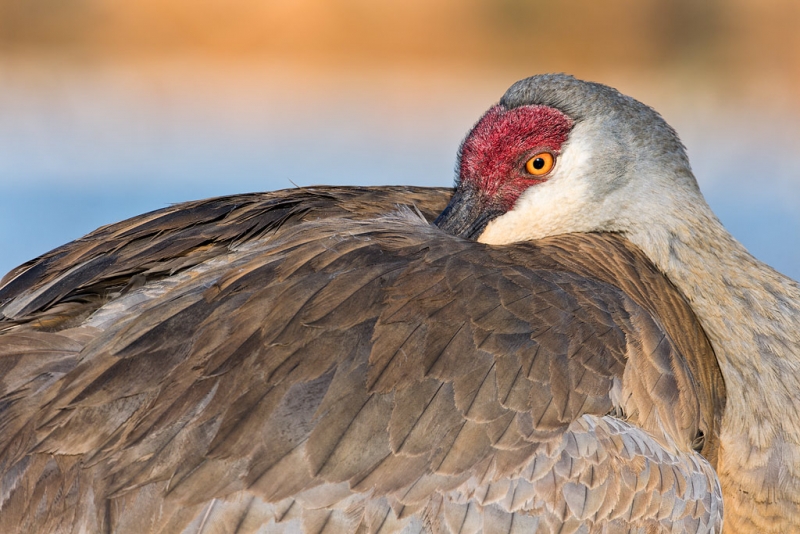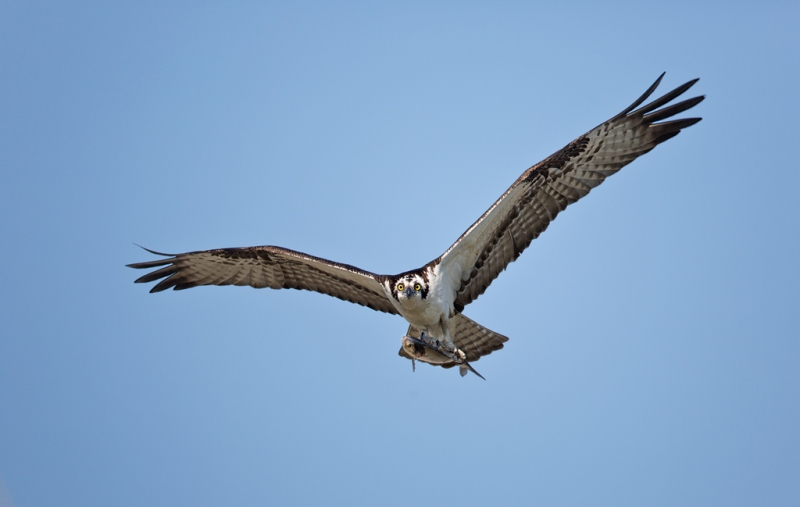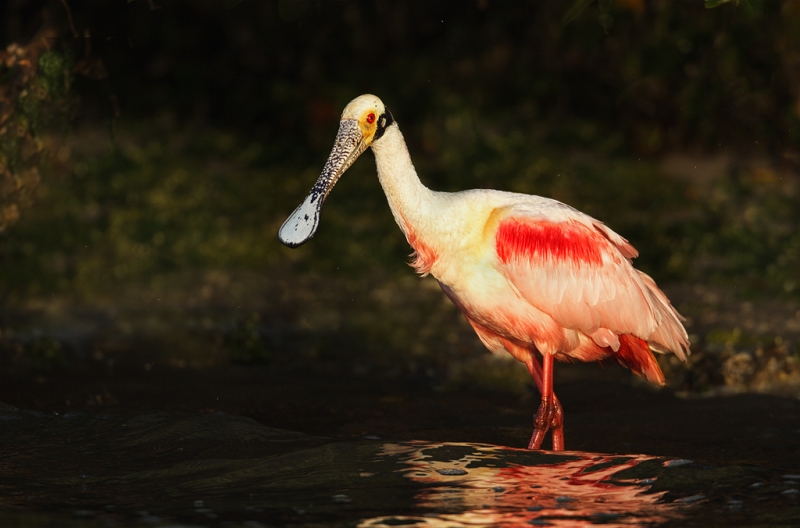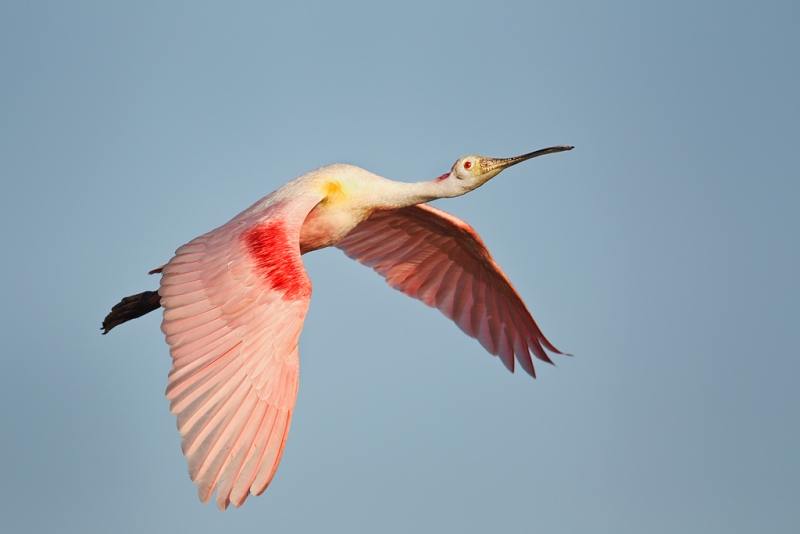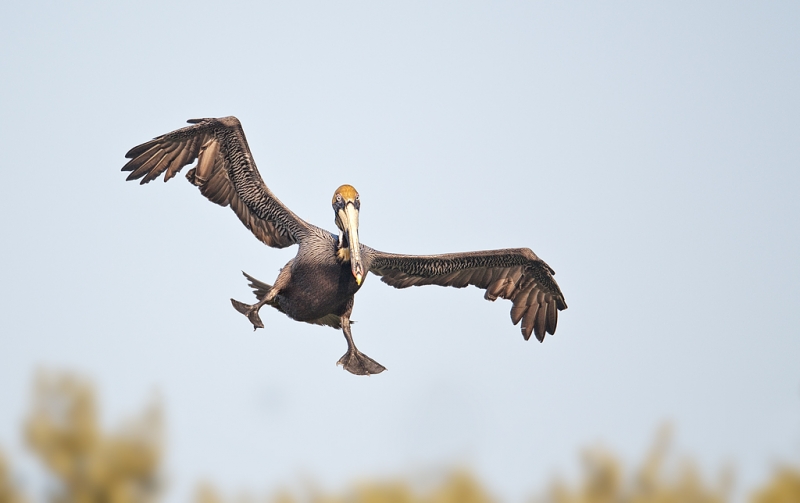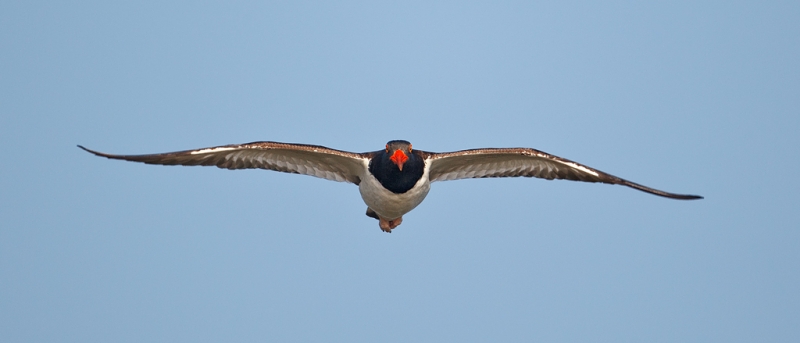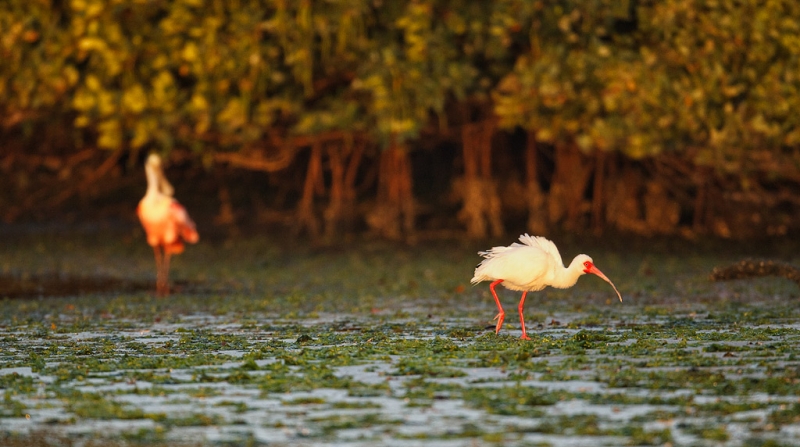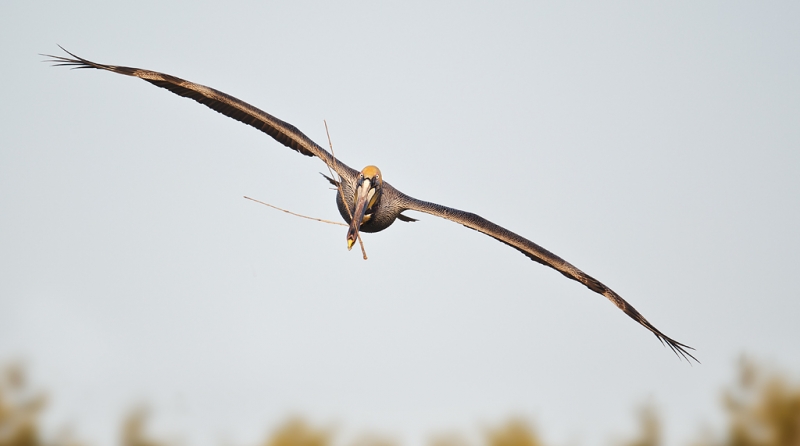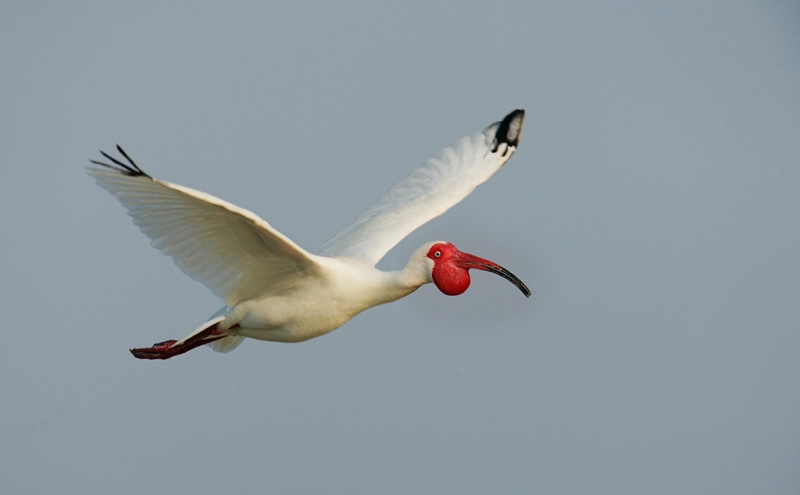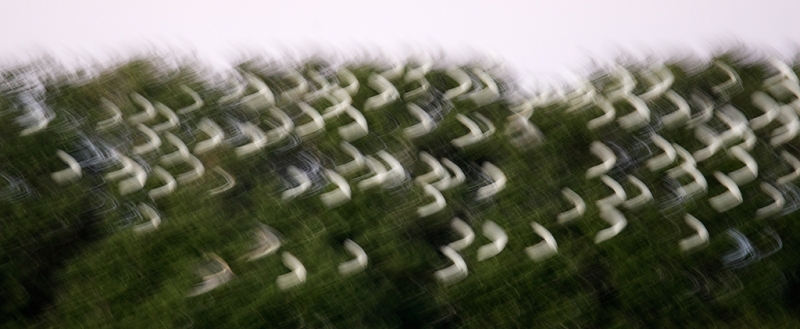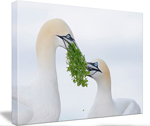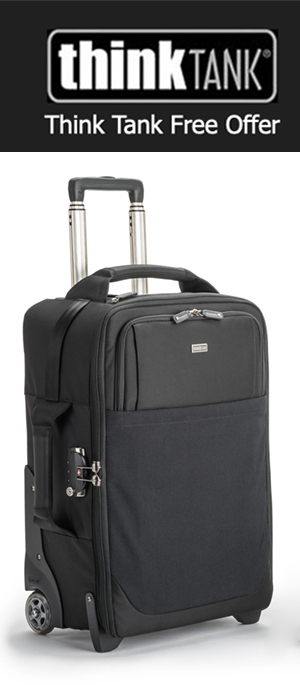April 21st, 2012
|
|
|
Cattle Egret, mega-breeding plumage. This image was created with the tripod-mounted Canon 800mm f/5.L IS lens, the 2XIII teleconverter, and the Canon EOS-5D Mark III. ISO 400. Evaluative metering at zero confirmed by histogram check: 1/640 sec. at f/11 in Manual mode–early morning light at 7:56 am.
I love the soft light, the exquisite sharpness, the multi-colored background, and the bright colors of the soft parts. The soft parts include the lores–the skin in front of the eye, the bill, and the feet (that are of course not seen here). These bright colors are the result of increased hormonal flow during the breeding season. Lores, bill, and additional clean-up work was done; see below for details.
See immediately below for AF info. Wait: autofocus with an f/5.6 lens and a 2X TC with a camera that focuses only to f/5.6…. How can that be??? As I said, read on for the AF info 🙂
|
Pushing the Limits with the Canon EOS-5D Mark III–2X III Teleconverter–800mm f/5.6L IS Combination
Many folks are asking, “Won’t you miss the 1.3 crop factor of your Mark IV body and its ability to focus to f/8?” The answer, as detailed in part in Gear Strategy here, is yes, at times. But…. Whenever I can get close with the 5D III I wind up with a lot more pixels on the bird. With tame birds that works out to a 22.3 megapixel to 16.1 megapixel advantage for the 5D III. If my math is correct that works out to a 38 1/2 per cent increase in pixels on the subject. Not to mention that I love the 5D III files and that those files exhibit at least a half stop better high ISO noise control than Mark IV files. When working with skittish or otherwise unapproachable subjects the MIV has a small advantage. Throw in a teleconverter and that becomes a large advantage. Again, see the Gear Strategy post here.
However, by knowing your gear inside and out you can push the limits of your lens/camera set-up. When I saw the drop-dead gorgeous Cattle Egret in mege-breeding plumage I knew that I wanted to capture a full frame head portrait. And I wanted it with everyone of my newly available 22.3 megapixels. Do understand that you need a qualifying situation…. This bird was one of a pair that sat for a few minutes at a time so rather than go to the Mark IV with the 1.4X TC on the 800 I went for the whole nine yards. I mounted the 2X III TC on the 800 in front of the 5D Mark III. I made sure that AF Mode was set to Live Mode. Then I framed the image through the viewfinder and pre-focused. Then I turned on Live View, pressed the * button for Rear Focus AF, and made a series of images. Additional important details on this technique will be included in the 5D Mark III User’s Guide and the update of the EOS-1D Mark IV User’s Guide. (It will take me a while to get to the latter.)
If the bird changes its position or moves to a new perch, you need to start from scratch. Live Mode/Live View AF works only with static subject. BTW, the image above was not a result of luck; I created 4-7 sharp keepers of this and several other pose/background combinations.
Have you ever seen a more beautiful individual of this species?
|
|
|
This JPEG represents the original capture from which the image above was created.
|
Bill clean-up was done with the Patch Tool, the Clone Stamp Tool, and the Spot Healing Brush, all as described in detail in Digital Basics. The old wound on the chin was covered with a warped Quick Mask as described in detail in APTATS I.
Important Contest News
Only Two Days Left to Enter the Competition!
Only Two Days Left to Make Your Qualifying B&H Purchases!
Only Nine Days Left to Upload Your Photos!
While you may upload images until 11:59pm eastern time on April 30, 2012, the very last day for registering for the contest and for making eligible B&H purchases will be Monday, April 23, 2012. This will give us time to process your registrations and verify your B&H purchases and will give you time to upload your images successfully. Good luck to all.
The BIRDS AS ART 1st International Bird Photography Competition has been going great guns. Additional folks are getting in on the fun each day. And many folks who had previously finished their entries have been taking advantage of the extension by uploading even stronger images. Thanks to those who responded to my Hand of Man pleas; it is now one of our strongest categories. While each of the following categories has some very strong images there is still room for improvement: Small in the Frame/Environmental, Pleasing Blurs, Youth, and especially Captive (photographs of captive, zoo, pet, or rehab birds).
Those of you who have been in the dark can learn more about the BIRDS AS ART 1st International Bird Photography Competition here or by visiting the main contest page here.
Save Your B&H Receipts
Do save your e-mail receipts for eligible B&H purchases made after Monday, April 23 as you will be able to use them for entry into the BIRDS AS ART 2nd International Bird Photography Competition; details will be announced in several months. Please remember, only B&H purchases made using the product-specific BAA B&H affiliate links in the Bulletins or on the blog or the more general link here qualify. See additional details by scrolling down to item 2 here. If in doubt, simply start your B&H searches by clicking here:
Earn Free Contest Entries and Support both the Bulletins and the Blog by making all your B & H purchases here.
More and more folks are earning multiple contest entries with their B & H purchases. See here for details on that. Eleven great categories, 34 winning and honored images, and prize pools valued in excess of $20,000. Click here to visit the competition home page.
Shopper’s Guide
Below is a list of the gear used to create the images in today’s post. Thanks a stack to all who have used the Shopper’s Guide links to purchase their gear as a thank you for all the free information that we bring you on the Blog and in the Bulletins. Before you purchase anything be sure to check out the advice in our Shopper’s Guide.
Canon 800mm f/5.6L IS lens. Right now this is my all time favorite super-telephoto lens.
2XIII teleconverter. This TC is noticeably sharper and is designed to work best with the new Series II teleconverters.
Canon EOS-5D Mark III. Man, I am in love with this camera body. Both the files and the AF system are superb.
And from the BAA On-line Store:
LensCoats. I have a LensCoat on each of my big lenses to protect them from nicks and thus increase their re-sales value. All my big lens LensCoat stuff is in Hardwood Snow pattern.
LegCoat Tripod Leg Covers. I have four tripods active and each has a Hardwood Snow LegCoat on it to help prevent further damage to my tender shoulders 🙂 And you will love them in mega-cold weather….
Gitzo GT3530LS Tripod. This one will last you a lifetime.
Mongoose M3.6 Tripod Head. Right now this is the best tripod head around for use with lenses that weigh less than 9 pounds. For heavier lenses, check out the Wimberley V2 head.
CR-80 Replacement Foot for Canon 800. When using the 800 on a Mongoose as I do, replacing the lens foot with this accessory lets the lens sit like a dog whether pointed up or down and prevents wind-blown spinning of your lens on breezy days by centering the lens directly over the tripod.
Double Bubble Level. You will find one in my camera’s hot shoe whenever I am not using flash.
The Lens Align Mark II. I use the Lens Align Mark II pretty much religiously to micro-adjust all of my gear an average of once a month and always before a major trip. Enjoy our free comprehensive tutorial here.
BreezeBrowser. I do not see how any digital photographer can exist without this program.
April 19th, 2012
|
|
|
This image was created with the hand held Canon 70-200mm f/2.8L IS II lens, the 2XIII teleconverter (hand held at 400mm), and the Canon EOS-5D Mark III. ISO 400. Evaluative metering +2/3 stop: 1/2500 sec. at f/5.6 in Manual mode.
AI Servo Rear Focus AF active at the moment of exposure. Click here if you missed the Rear Focus Tutorial. Be sure to click on the image to see the spectacular larger version.
|
Free 5DIII Info
Many folks have e-mailed asking how to set up rear focus on the Canon EOS-5D Mark III. It is a bit hidden in the extensive Menu/Custum Functions screens. Here’s how you do it:
The last item on the 2nd Custom Function (C.Fn3: Display/Operation–Orange) Menu is Custom Controls. Select Custom Controls by scrolling down with the thumb wheel and then hit Set.
The first item in the left hand column is Shutter Button half-press. The default there is Metering and AF start. With the orange outline around this first item Press Set. You will see the orange outline around the Metering/AF symbol. Turn the thumb wheel one click clockwise that the orange outline is around the metering (only) symbol. Now press set again.
Next, scroll down to the second item in the first column, the AF-ON button. The default there is Metering/AF. Press set and turn the thumb wheel one click clockwise so that the orange box is around the * (exposure lock) symbol. Now press Set again. Only one more to go. Turn the thumb wheel one click in the clockwise direction to highlight the * button. The default there is the * button, i.e., exposure lock. Now press the Set button, turn the thumb wheel clockwise one click so that the Metering/AF symbol is outlined in orange. Press Set one last time and touch the shutter button lightly to exit the menu screen and you are good to go.
Metering will become active when you press the shutter button halfway but the camera will not focus. (That’s what rear focus is all about.) Focus by pushing the star button–the second button in from the upper right back corner of the body. And release the shutter button to create an image by fully depressing the shutter button. On the rare occasion that you need to lock the exposure you will use the AF-ON button as we have effectively switched the functions of the AF-ON and the star buttons.
When using rear focus you want to be in AI Servo AF all the time. You have One-Shot AF available by pressing the star button to set focus. You can then release the star button and recompose. To follow a swimming, walking, running, or flying bird simply press and hold the star button. In either situation, simply press the shutter button fully to create an image or press and hold the shutter button down fully to create a series of images. Remember: if you lift your thumb off the star button the AF system will stop tracking.
Two years ago I went to rear focus full time with all camera bodies and have never looked back. You can read the original rear focus tutorial here.
This is the type of information that will be available in spades in the upcoming EOS-5D Mark III User’s Guide. I hope to have it completed in one month but may be offering a pre-publication version at a discount soon.
|
|
|
This image was created with the Canon 70-200mm f/2.8L IS II lens and the 1.4X III TC (hand held at 115mm) with the Canon EOS-5D Mark III. ISO 400. Evaluative metering + 1/3 stops: 1/800 sec. at f/6.3 in Manual mode.
Central Sensor/AI Servo Rear Focus AF and re-compose. My elbows were braced on the railing to ensure that the lens did not move in relation to the subject after focus was set…. Click here if you missed the Rear Focus Tutorial. Be sure to click on the image to see a larger version.
|
Important Contest News
Only Four Days Left to Enter the Competition!
Only Four Days Left to Make Your Qualifying B&H Purchases!
Only Eleven Days Left to Upload Your Photos!
While you may upload images until 11:59pm eastern time on April 30, 2012, the very last day for registering for the contest and for making eligible B&H purchases will be Monday, April 23, 2012. This will give us time to process your registrations and verify your B&H purchases and will give you time to upload your images successfully. Good luck to all.
The BIRDS AS ART 1st International Bird Photography Competition has been going great guns. Additional folks are getting in on the fun each day. And many folks who had previously finished their entries have been taking advantage of the extension by uploading even stronger images. Thanks to those who responded to my Hand of Man pleas; it is now one of our strongest categories. While each of the following categories has some very strong images there is still room for improvement: Small in the Frame/Environmental, Pleasing Blurs, Youth, and especially Captive (photographs of captive, zoo, pet, or rehab birds).
Those of you who have been in the dark can learn more about the BIRDS AS ART 1st International Bird Photography Competition here or by visiting the main contest page here.
Save Your B&H Receipts
Do save your e-mail receipts for eligible B&H purchases made after Monday, April 23 as you will be able to use them for entry into the BIRDS AS ART 2nd International Bird Photography Competition; details will be announced in several months. Please remember, only B&H purchases made using the product-specific BAA B&H affiliate links in the Bulletins or on the blog or the more general link here qualify. See additional details by scrolling down to item 2 here. If in doubt, simply start your B&H searches by clicking here:
Earn Free Contest Entries and Support both the Bulletins and the Blog by making all your B & H purchases here.
More and more folks are earning multiple contest entries with their B & H purchases. See here for details on that. Eleven great categories, 34 winning and honored images, and prize pools valued in excess of $20,000. Click here to visit the competition home page.
Shopper’s Guide
Below is a list of the gear used to create the images in today’s post. Thanks a stack to all who have used the Shopper’s Guide links to purchase their gear as a thank you for all the free information that we bring you on the Blog and in the Bulletins. Before you purchase anything be sure to check out the advice in our Shopper’s Guide.
Canon 70-200mm f/2.8L IS II lens. Man, I am loving this lens on my shoulder with the 2XIII teleconverter. I also use it a lot–depending on the situation–with the 1.4X III TC.
Canon EOS-5D Mark III. Man, I am in love with this camera body. Both the files and the AF system are superb. I cannot wait to get to Morro Bay.
And from the BAA On-line Store:
The Lens Align Mark II. I use the Lens Align Mark II pretty much religiously to micro-adjust all of my gear an average of once a month and always before a major trip. Enjoy our free comprehensive tutorial here.
BreezeBrowser. I do not see how any digital photographer can exist without this program.
April 18th, 2012
|
|
|
When photographing tall birds in horizontal format keep the bird well back in the frame. Here there is about four times more room in front of the bird than behind. Using the central sensor and placing the bird in the middle of the frame in situations like this is a criminal offense. You can choose a sensor off to one side of the frame, use One-Shot AF(S in Nikon) and recompose, or use central sensor AI Servo (C in Nikon)/Rear Focus and re-compose. Do not try to stuff a tall bird into a horizontal frame; be sure to leave a decent amount of room above and below the bird–usually a bit more above.
Tricolored Heron, Little Estero Lagoon, Fort Myers Beach, FL Image created with Canon 70-200mm f/2.8L IS II lens, the 1.4X III TC (hand held at 255mm), and the Canon EOS-1D Mark IV. ISO 250. Evaluative metering at +2 stops: 1/300 sec. at f/4 in Tv mode.
|
Bird Photography Composition Basics
Five simple rules are presented here. Learn them and your work will improve immeasurably. Think about them every time that you point your lens at a bird. Or a bear. Or at anything else. The principles outlined here hold true even when you are photographing your kids or your grandchildren. Break them when you dare, but only when you have a good reason for doing so. If you do not own these principles, bookmark this page and keep coming back until you do.
|
|
|
When photographing a large in the frame bird in horizontal format, leave three to five times as much space from the bird’s bill to the frame-edge than from the end of the tail to the opposite frame-edge. In sort, nobody gives a rat’s ass what’s going on behind the bird. In general, leave at least a bit more room above the bird than below.
Northern Cardinal, Elizabeth A. Morton NWR, Noyack, NY. This image was created with the tripod-mounted Canon 800mm f/5.L IS lens and the Canon EOS-1D Mark IV. ISO 800. Evaluative metering +2 2/3 stops off the snow: 1/160 sec. at f/8 in Manual mode.
|
Motivation
My motivation for writing this piece arose from the frustration of seeing so many folks on Bird Photographers.Net and during BIRDS AS ART Instructional Photo Tour critiquing sessions who simply do not understand the basics of image design. These principles are covered in detail in the original “The Art of Bird Photography.” Often when I suggest that folks purchase the book and study the basics of composition they say, “I have that book. It’s great.” That leaves me scratching my head…. Many folks think that buying the latest/greatest camera body and a $10,000 lens will transform them into a skilled bird photographer when what they really need to do is work harder by studying and practicing.
|
|
|
The rule of thirds has been guiding artists for centuries for good reason: it works. In nature photography it works especially well when your relatively small-in-the-frame subject is surrounded by beautiful habitat. Divide the frame in thirds horizontally and vertically and place the subject on or near one of the four intersecting points.
Grizzly Bear, Denali National Park, AK. Image created with hand held Canon 300mm f/4L IS lens and the EOS-1D (this oldie now replaced by the Canon EOS-1D Mark IV). ISO 400. Evaluative metering -1/3 stop: 1/640 sec. at f/4 in Av mode. (Ah, I have learned a ton about digital exposure since I created this image in 2004….)
|
Study!
If you have already mastered the principles covered here then do consider purchasing “The Art of Bird Photography II,” copying it to the hard drive of your laptop, and studying Chapter II, Advanced Composition and Image Design (pages 163-254 including 97 images with our legendary educational captions). See the ABP II screen capture below.
|
|
|
Tall, relatively large–in-the-frame birds (even baby ones) need to be in vertical frames. If they are looking at you they usually work best dead center. If they are looking to one side, you can place them a bit back in the frame as I did here. Be sure to leave well more room above their heads than below their feet. Note here that there is twice as much room above the bird than below. And be sure not to clip the virtual feet, feet that are hidden by tall grass or shallow water.
Sandhill Crane chick, Indian Lake Estates, FL, with the tripod-mounted Canon 800mm f/5.L IS lens, the 1.4X III TC, and the Canon EOS-1D Mark IV. ISO 400. Evaluative metering at +1 stop: 1/1250 sec. at f/8 in Av mode.
|
Staggering
The amount of information and instruction in the original ABP and the all-new continuation, ABP II is simply staggering. Oh how I wish that I had had these two books when I was struggling to learn bird photography in the ten years that followed August 1983. Today, you can save $10 by purchasing the two book bundle here.
|
|
|
Small-in-the-frame subjects must be placed in the corners of vertical frames. This type of image works best when you wish to show off a beautiful setting.
Atlantic Puffin, Saltee Island, Ireland with the hand held Canon 400mm f.4L IS DO lens and the EOS-40D (now replaced with the Canon EOS-7D. ISO 400. Evaluative metering at +1/3 stop: 1/500 sec. at f/0 in Av mode.
|
Improve
By studying the material presented here, learning to use your camera’s AF system to it fullest capabilities, and looking at as many good and great photographs as possible, you too can begin producing images that feature pleasing, interesting, and dramatic compositions.
|
|
|
Pages 203/204 screen capture from ABP II’s Advanced Composition and Image Design Gallery. Most of the chapters in ABP II are followed by extensive galleries that review the material covered in the text. Click on the screen capture to see a larger version.
|
Important Contest News
Only Five Days Left to Enter the Competition!
Only Five Days Left to Make Your Qualifying B&H Purchases!
Only Twelve Days Left to Upload Your Photos!
While you may upload images until 11:59pm eastern time on April 30, 2012, the very last day for registering for the contest and for making eligible B&H purchases will be Monday, April 23, 2012. This will give us time to process your registrations and verify your B&H purchases and will give you time to upload your images successfully. Good luck to all.
The BIRDS AS ART 1st International Bird Photography Competition has been going great guns. Additional folks are getting in on the fun each day. And many folks who had previously finished their entries have been taking advantage of the extension by uploading even stronger images. Thanks to those who responded to my Hand of Man pleas; it is now one of our strongest categories. While each of the following categories has some very strong images there is still room for improvement: Small in the Frame/Environmental, Pleasing Blurs, Youth, and especially Captive (photographs of captive, zoo, pet, or rehab birds).
Those of you who have been in the dark can learn more about the BIRDS AS ART 1st International Bird Photography Competition here or by visiting the main contest page here.
Save Your B&H Receipts
Do save your e-mail receipts for eligible B&H purchases made after Monday, April 23 as you will be able to use them for entry into the BIRDS AS ART 2nd International Bird Photography Competition; details will be announced in several months. Please remember, only B&H purchases made using the product-specific BAA B&H affiliate links in the Bulletins or on the blog or the more general link here qualify. See additional details by scrolling down to item 2 here. If in doubt, simply start your B&H searches by clicking here:
Earn Free Contest Entries and Support both the Bulletins and the Blog by making all your B & H purchases here.
More and more folks are earning multiple contest entries with their B & H purchases. See here for details on that. Eleven great categories, 34 winning and honored images, and prize pools valued in excess of $20,000. Click here to visit the competition home page.
Shopper’s Guide
Below is a list of the gear used to create the images in today’s post. Thanks a stack to all who have used the Shopper’s Guide links to purchase their gear as a thank you for all the free information that we bring you on the Blog and in the Bulletins. Before you purchase anything be sure to check out the advice in our Shopper’s Guide.
Canon 800mm f/5.6L IS lens. Right now this is my all time favorite super-telephoto lens.
Canon 70-200mm f/2.8L IS II lens. Man, I am loving this lens on my shoulder with the 2XIII teleconverter. I also use it a lot–depending on the situation–with the 1.4X III TC.
Canon EF 1.4X III TC. This new TC is designed to work best with the new Series II super-telephoto lenses.
Canon 300mm f/4L IS lens. This lightweight, close-focusing telephoto lens is still manufactured. With the 1.4X III TC it makes a great starter lens for beginning bird photographers, especially those with 1.6 crop factor bodies like the Canon EOS-7D.
Canon 400mm f.4L IS DO lens. A lightweight image stabilized telephoto lens that is easily hand held by most folks, great from any kind of boat, and super for flight photography. Works well with both Series III teleconverters.
Canon EOS-1D Mark IV professional digital camera body. The very best professional digital camera body that I have ever used.
And from the BAA On-line Store:
LensCoats. I have a LensCoat on each of my big lenses to protect them from nicks and thus increase their re-sales value. All my big lens LensCoat stuff is in Hardwood Snow pattern.
LegCoat Tripod Leg Covers. I have four tripods active and each has a Hardwood Snow LegCoat on it to help prevent further damage to my tender shoulders 🙂 And you will love them in mega-cold weather….
Gitzo GT3530LS Tripod. This one will last you a lifetime.
Mongoose M3.6 Tripod Head. Right now this is the best tripod head around for use with lenses that weigh less than 9 pounds. For heavier lenses, check out the Wimberley V2 head.
CR-80 Replacement Foot for Canon 800. When using the 800 on a Mongoose as I do, replacing the lens foot with this accessory lets the lens sit like a dog whether pointed up or down and prevents wind-blown spinning of your lens on breezy days by centering the lens directly over the tripod.
Double Bubble Level. You will find one in my camera’s hot shoe whenever I am not using flash.
The Lens Align Mark II. I use the Lens Align Mark II pretty much religiously to micro-adjust all of my gear an average of once a month and always before a major trip. Enjoy our free comprehensive tutorial here.
BreezeBrowser. I do not see how any digital photographer can exist without this program.
April 15th, 2012
|
|
|
This image was created with the hand held Canon 70-200mm f/2.8L IS II lens, the 2XIII teleconverter (hand held at 400mm), and the Canon EOS-5D Mark III. ISO 200. Thought that I was at ISO 400….: 1/400 sec. at f/11 in Manual mode.
AI Servo Rear Focus AF active at the moment of exposure. Click here if you missed the Rear Focus Tutorial. Be sure to click on the image to see the spectacular larger version.
|
Is the EOS-5D Mark III–2X III Teleconverter–70-200f/2.8L IS II a Viable Combination?
In a word. Yes. The combination is incredibly sharp. In addition, I tried it a bit for flight photography with somewhat mixed results in very difficult conditions; there were no hangers. I am not sure how I got to ISO 200 but I love the end result above. See the animated GIF below for image clean-up details. NIK Color Efex Pro Tonal Contrast at 30% and White Neutralizer at 60%.
Image clean-up involved a combination of Clone Stamp Tool and Patch Tool work to execute the Divide and Conquer strategy and a series of flopped and warped Quick Masks that were fine tuned with Layer Masks. All as described in detail in Digital Basics and Robert’s O’Toole’s APTATS I (Quick Masks) and APTATS II (Layer Masks). I first lightened the image during ACR conversion and then again using the Curves filter in NIK Color Efex Pro. As soon as I saw the shade of blue water I knew that White Neutralizer would make it sing.
As regular readers know NIK’s Color Efex Pro 4 is now an integral part of my workflow. Click here for an excellent NIK Color Efex Pro Tutorial. And remember, you can save 15% on all NIK products by clicking here and entering BAA in the Promo Code box at check-out. Then hit Apply to see your savings. You can download a trial copy that will work for 15 days and allow you to create full sized images.
Contest Update
The BIRDS AS ART 1st International Bird Photography Competition has been going great guns. Additional folks are getting in on the fun each day. And many folks who had previously finished their entries have been taking advantage of the extension by uploading even stronger images. Thanks to those who responded to my Hand of Man pleas; it is now one of our strongest categories. While each of the following categories has some very strong images there is still room for improvement: Small in the Frame/Environmental, Pleasing Blurs, Youth, and especially Captive (photographs of captive, zoo, pet, or rehab birds).
Those of you who have been in the dark can learn more about the BIRDS AS ART 1st International Bird Photography Competition here or by visiting the main contest page here.
Important Contest News
While you may upload images until 11:59pm eastern time on April 30, 2012, the very last day for registering for the contest and for making eligible B&H purchases will be Monday, April 23, 2012. This will give us time to process your registrations and verify your B&H purchases and will give you time to upload your images successfully. Good luck to all.
Do save your e-mail receipts for eligible B&H purchases made after Monday, April 23 as you will be able to use them for entry into the BIRDS AS ART 2nd International Bird Photography Competition; details will be announced in several months. Please remember, only B&H purchases made using the product-specific BAA B&H affiliate links in the Bulletins or on the blog or the more general link here qualify. See additional details by scrolling down to item 2 here. If in doubt, simply start your B&H searches by clicking here:
Earn Free Contest Entries and Support both the Bulletins and the Blog by making all your B & H purchases here.
More and more folks are earning multiple contest entries with their B & H purchases. See here for details on that. Eleven great categories, 34 winning and honored images, and prize pools valued in excess of $20,000. Click here to visit the competition home page.
Shopper’s Guide
Below is a list of the gear used to create the images in today’s post. Thanks a stack to all who have used the Shopper’s Guide links to purchase their gear as a thank you for all the free information that we bring you on the Blog and in the Bulletins. Before you purchase anything be sure to check out the advice in our Shopper’s Guide.
Canon 70-200mm f/2.8L IS II lens. Man, I am loving this lens on my shoulder with the 2XIII teleconverter. I also use it a lot–depending on the situation–with the 1.4X III TC.
Canon EOS-5D Mark III. Man, I am in love with this camera body. Both the files and the AF system are superb. I cannot wait to get to Morro Bay.
And from the BAA On-line Store:
The Lens Align Mark II. I use the Lens Align Mark II pretty much religiously to micro-adjust all of my gear an average of once a month and always before a major trip. Enjoy our free comprehensive tutorial here.
BreezeBrowser. I do not see how any digital photographer can exist without this program.
April 13th, 2012
|
|
|
The Western Gulls were eating blood-filled who-knows-whats every afternoon. They would land with them, squeeze them till they burst creating a shower of what seemed to be blood, take flight, and eventually swallow them. This image was created with the tripod-mounted Canon 800mm f/5.L IS lens and the Canon EOS-5D Mark III. ISO 400. Evaluative metering +1 stop off the sky: 1/2000 sec. at f/5.6 in Manual mode.
Central Sensor–Expand AF area/AI Servo Rear Focus AF active at the moment of exposure. Click here if you missed the Rear Focus Tutorial.
The 5D Mark III is my go-to flight photography body. The new AF system is superb. Click on the image for a larger version.
|
EOS-5D MII–EOS-1D Mark IV Gear Strategy
Here is my current gear strategy:
Whenever possible I will use my EOS-5D Mark III for all flight photography whether with the 800mm f/5.6L IS or the 70-200mm f/2.8L IS with or without the 1.4XIII TC. 5D MIII AF is that good.
When working with birds at relatively close range I will use my EOS-5D Mark III with the 800mm f/5.6L IS lens as my everyday go-to rig.
When I need more reach I will use the EOS-1D Mark IV with the 1.4X III TC on the 800.
|
|
|
This tiny Pied-billed Grebe was photographed with the tripod-mounted Canon 800mm f/5.L IS lens, the 1.4X III TC, and the Canon EOS-1D Mark IV. ISO 400. Evaluative metering at +2/3 stop: 1/160 sec. at f/8 in Manual mode.
Central sensor (by necessity) AI Servo/Rear Focus AF active at the moment of exposure. Click here if you missed the Rear Focus Tutorial. Click on the image for a larger version.
Here I went to the 800/1.4X III/Mark IV combo for maximum reach.
|
How I Do It
In order to implement this strategy I will use one of the two options that I used in Morro Bay:
1- Head afield with the 5D III on the 800 on the tripod with the EOS-1D Mark IV in one of the large front pockets of my Xtrahand vest with the 1.4X III TC attached. When and if I need more focal length I will simply remove the 5DIII and mount the 1D IV.
2- Head afield with the 5D III on the 800 on the tripod with the EOS-1D Mark IV and the 1.4X III TC on the 70-200mm f/2.8L IS lens on my shoulder via a Black Rapid RS-7 strap. When I need more focal length I will simply switch the camera bodies.
|
|
|
To create this Western Grebe image I used the Canon 800mm f/5.L IS lens and the Canon EOS-1D Mark IV. ISO 400. Evaluative metering at zero: 1/640 sec. at f/10 in Manual mode.
Central sensor on the grebe’s neck/AI Servo/Rear Focus AF active at the moment of exposure. Click here if you missed the Rear Focus Tutorial. Click on the image for a larger version.
|
Right after photographing the Pied-billed Grebe the sun came out and this Western Grebe swam into range. Being a much larger bird I simply took off the 1.4X III TC and held it in my left hand as I photographed.
|
|
|
This image was created with the hand held Canon 70-200mm f/2.8L IS II lens, the 1.4X III TC (at 280mm), and the Canon EOS-1D Mark IV. ISO 250. Evaluative metering at +1 stops: 1/250 sec. at f/4.5 in Tv mode.
Central Sensor/AI Servo Rear Focus and recompose. Click here if you missed the Rear Focus Tutorial. Click on the image to enjoy a larger version.
|
Having the 70-200 along with both camera bodies and a 1.4XIII TC gives me a wide range of focal lengths that I can use to create bird-scapes like the one above. When I saw the Willets flying in I focused on the closet bird on the beach and let the showy sandpipers fly into prime position before making a series of images.
|
|
|
The Western Gull image was created with the tripod-mounted Canon 800mm f/5.L IS lens and the Canon EOS-5D Mark III. ISO 400. Evaluative metering +1 1/3 stops off the sky: 1/2000 sec. at f/5.6 in Manual mode.
Central Sensor–Expand AF area/AI Servo Rear Focus AF active at the moment of exposure. Click here if you missed the Rear Focus Tutorial. Click on the image for a larger version. Click on the image for a larger version.
|
The 5D MIII AF system worked well for flight even with backgrounds other than sky as you can see here. Working in Manual mode is the key to success when the background might change from sky to hillside in an instant. The exposure at the moment the shutter was released here was probably about -1/3 stop as framed.
|
|
|
This Black Turnstone image was created with the tripod-mounted Canon 800mm f/5.L IS lens and the Canon EOS-5D Mark III. ISO 400. Evaluative metering +1/3 stop: 1/800 sec. at f/9 in Manual mode.
Central Sensor/AI Servo Rear Focus AF and recompose. Click here if you missed the Rear Focus Tutorial. Click on the image for a larger version.
|
My young co-leader Adian Briggs brought us to a rocky area along the coast. Over time we found both Black Turnstone and Black Oystercatcher. When he said the the birds would be approachable I went with the 5D III/800 combo and left everything else in the car. It turned out to be the perfect move.
|
|
|
This image was created with the hand held Canon 70-200mm f/2.8L IS II lens and the Canon EOS-5D Mark III. ISO 400. Evaluative metering at +2 1/3 stops: 1/4000 sec. at f/2.8 in Manual mode.
Central Sensor–Expand AF area/AI Servo Rear Focus AF active at the moment of exposure. Click here if you missed the Rear Focus Tutorial. Click on the image for a larger version.
|
When we spent a few minutes tossing bread to the gulls in the shadow of Morro Rock I grabbed the 70-200 and the 5D III and went to work. It performed superbly even creating sharp on the eye images every time even at the wide open aperture.
Rejoinder
The strategy above is my current strategy. If you meet me in the field tomorrow I might be doing something different. Why? I am learning more about my new camera every day and things may change rapidly.
By the way, I would expect that folks with either a 500 or 600mm f/4L IS lens who own both a 5D III and Mark IV might employ a similar strategy with their 2X teleconverters….
Which Image Do You Like Best?
Take a moment to let us know which image you like best, and why you like it.
Contest Update
The BIRDS AS ART 1st International Bird Photography Competition has been going great guns. Additional folks are getting in on the fun each day. And many folks who had previously finished their entries have been taking advantage of the extension by uploading even stronger images. Thanks to those who responded to my Hand of Man pleas; it is now one of our strongest categories. While each of the following categories has some very strong images there is still room for improvement: Small in the Frame/Environmental, Pleasing Blurs, Youth, and especially Captive (photographs of captive, zoo, pet, or rehab birds).
Those of you who have been in the dark can learn more about the BIRDS AS ART 1st International Bird Photography Competition here or by visiting the main contest page here.
Important Contest News
While you may upload images until 11:59pm eastern time on April 30, 2012, the very last day for registering for the contest and for making eligible B&H purchases will be Monday, April 23, 2012. This will give us time to process your registrations and verify your B&H purchases and will give you time to upload your images successfully. Good luck to all.
Do save your e-mail receipts for eligible B&H purchases made after Monday, April 23 as you will be able to use them for entry into the BIRDS AS ART 2nd International Bird Photography Competition; details will be announced in several months. Please remember, only B&H purchases made using the product-specific BAA B&H affiliate links in the Bulletins or on the blog or the more general link here qualify. See additional details by scrolling down to item 2 here. If in doubt, simply start your B&H searches by clicking here:
Earn Free Contest Entries and Support both the Bulletins and the Blog by making all your B & H purchases here.
More and more folks are earning multiple contest entries with their B & H purchases. See here for details on that. Eleven great categories, 34 winning and honored images, and prize pools valued in excess of $20,000. Click here to visit the competition home page.
Shopper’s Guide
Below is a list of the gear used to create the images in today’s post. Thanks a stack to all who have used the Shopper’s Guide links to purchase their gear as a thank you for all the free information that we bring you on the Blog and in the Bulletins. Before you purchase anything be sure to check out the advice in our Shopper’s Guide.
Canon 800mm f/5.6L IS lens. Right now this is my all time favorite super-telephoto lens.
Canon 70-200mm f/2.8L IS II lens. Man, I am loving this lens on my shoulder with the 2XIII teleconverter. I also use it a lot–depending on the situation–with the 1.4X III TC.
Canon EF 1.4X III TC. This new TC is designed to work best with the new Series II super-telephoto lenses.
Canon EOS-5D Mark III. Man, I am in love with this camera body. Both the files and the AF system are superb.
Canon EOS-1D Mark IV professional digital camera body. The very best professional digital camera body that I have ever used.
And from the BAA On-line Store:
LensCoats. I have a LensCoat on each of my big lenses to protect them from nicks and thus increase their re-sales value. All my big lens LensCoat stuff is in Hardwood Snow pattern.
LegCoat Tripod Leg Covers. I have four tripods active and each has a Hardwood Snow LegCoat on it to help prevent further damage to my tender shoulders 🙂 And you will love them in mega-cold weather….
Gitzo GT3530LS Tripod. This one will last you a lifetime.
Mongoose M3.6 Tripod Head. Right now this is the best tripod head around for use with lenses that weigh less than 9 pounds. For heavier lenses, check out the Wimberley V2 head.
CR-80 Replacement Foot for Canon 800. When using the 800 on a Mongoose as I do, replacing the lens foot with this accessory lets the lens sit like a dog whether pointed up or down and prevents wind-blown spinning of your lens on breezy days by centering the lens directly over the tripod.
Double Bubble Level. You will find one in my camera’s hot shoe whenever I am not using flash.
The Lens Align Mark II. I use the Lens Align Mark II pretty much religiously to micro-adjust all of my gear an average of once a month and always before a major trip. Enjoy our free comprehensive tutorial here.
BreezeBrowser. I do not see how any digital photographer can exist without this program.
April 12th, 2012
|
|
|
Join me on Midway and photograph three species of albatross until your arms are too tired to lift your rig…. Click on the composite image to enjoy a larger version.
|
MIDWAY 2013
MIDWAY ATOLL BAA IPT: March 25, 2013 (from Honolulu, Oahu, HI) 7-FULL DAYS OF PHOTOGRAPHY: $7995 ALL INCLUSIVE FROM HNL. Limit: 14/Openings 3.
There are only three slots open right now…. The trip schedule is now etched in stone and we are good to go. The price is firm barring any fuel surcharges. This might very well be the last year for tourism to this amazing spot….
The group will fly to Midway from the Charter Aircraft Hangar on the late afternoon of March 25, 2013. You will need to be in Honolulu by late morning on the 25th. For safety’s sake, I will be arriving in Honolulu on March 24 to avoid missing the charter flight. You should do the same. If you plan to arrive on the 25th and are delayed, you will miss the charter flight and will not be able to get to Midway. Period. If you do choose to arrive on the 24th as advised, the hotel is on your dime.
We will arrive at Midway after dark on the 25th. We will leave Midway well after dark on April 1 arriving in Honolulu during the very early morning of April 2, usually between 1 and 2 am. The cost of a hotel day-room is included in the trip. If you need late check-out (after noon on the 2nd) that will be on your dime too. Most flights back to the US are red-eyes.
We will enjoy seven full days of photography. We will enjoy hundreds of thousands of nesting albatrosses both Laysan and Black-footed. We will see and photograph (and video if you like) chicks of all sizes and the incredibly intricate courtship displays of both species. You will be able to create head portraits of both species with a 70-200 lens. We will enjoy hours of albatross flight photography. The morning runway flight photography is incredible. It is likely that we will see and get to photograph the exceedingly rare Short-tailed Albatross (though briefly because of access restrictions). We will see and photograph White (formerly Fairy) Tern as well as Red-tailed Tropicbird. After lunch on sunny days the skies in front of the Clipper House will be filled with courting Red-tailed Tropicbirds. Other likely subjects include Lasyan Duck, Pacific Golden-Plover and Bristle-thighed Curlew. Those who bring their flashes will be able to photograph Bonin’s Petrel after dark. I will likely leave my flash at home as there are severe weight restrictions on this trip; each of us will be limited to about 60 pounds total.
|
|
|
This Laysan Albatross chick was photographed with the Canon 70-200mm f/2.8L IS II lens, the 1.4X III TC (hand held at 250mm), and the Canon EOS-1D Mark IV. ISO 400. Evaluative metering -1/3 stop: 1/800 sec. at f/7.1 in Av mode. I needed to under-expose to prevent burning the rim lit feathers.
Central Sensor/AI Servo Rear Focus AF active at the moment of exposure. Click here if you missed the Rear Focus Tutorial. Click on the image to enjoy a larger version.
Imagine that here I needed to zoom out!
|
We will make a one day boat trip, about a 15 minute ride, to Eastern Island where we will see and photograph nesting Red-footed Booby and nesting Great Frigatebird with inflated red gular pouches. Grey-backed Tern and several other species are possible. And of course there will be zillions of nesting Laysan Albatrosses there. We can expect two species of noddy on the trip, Brown and Black–I think that the Black Noddies are more likely on Eastern Island. Both islands are rife with historical significance, derelict buildings and hangars, and artifacts; the naval battle of Midway was the turning point in World War II.
|
|
|
Midway is a world renowned wildlife photography destination that ranks right up there with Antarctica, East Africa, Japan in winter, and the Galapagos. And like the Galapagos, most of the wildlife is inordinately tame. Click on the composite image to enjoy a larger version.
|
In order to cover the huge expense of the round-trip charter aircraft to and from Midway Island this trip needs to fill in order to run. In the almost unimaginable event that this minimum is not met, or if the trip is denied government approval, your deposit will of course be refunded in full. It is otherwise non-refundable. Once the trip is confirmed you will be advised to purchase trip cancellation insurance. I do expect this trip to fill in very short order. A waiting list will be created for those who are late to respond. Please hold off purchasing plane tickets until you hear that the trip is a go. Do note that while many trips are advertised as once in a lifetime, this one may very well be that once in a lifetime opportunity as there is constant talk that each season may be the very last.
What’s included? The round trip charter airfare from HNL to Midway and back, all lodging and meals on Midway. The food, both American and Thai, is killer good so do not plan on losing any weight, all associated national park fees as well as transport via large golf cart. For the most part we will stay together as a group. Those wishing to photograph on their own with some restrictions may rent bikes. Also included is in-the-field instruction. Informal image sharing and Photoshop instruction will be available most days for those sitting next to me or looking over my shoulder in the lobby of Charley Barracks early mornings, evenings, and during break time. I do try to catch a short nap each day.
What’s not included: The cost of the airfare from your home to and from HNL. Your meals in Honolulu. The cost of your hotel room on March 24th and late check out if needed on April 2. Personal items and souvenirs purchased on Midway.
If you are a happy camper and wish to register for this trip please call us at 863-692-0906 immediately. If no answer do not leave a message but do send an e-mail to me at mailaddress. You will be given instructions for sending a deposit check for $800 to us here: Arthur Morris/BIRDS AS ART, PO Box 7245 (mail) or 4041 Granada Drive (courier), Indian Lake Estates, FL 33855. Your deposit is non-refundable.
For the folks who have never traveled with us, please remember, happy campers only. If you are a bitter and unhappy person we do not care to travel with you. If you are pleasant, fun, easy to get along with and know how to act in the field with a group, we would be delighted to have you along.
|
|
|
This Laysan Albatross was photographed in flight over the lagoon that surrounds the atoll. The black storm cloud was a rare bonus. I used the
Canon 70-200mm f/2.8L IS II lens, the 1.4X III TC (hand held at 118mm), and the Canon EOS-1D Mark IV. ISO 1000. Evaluative metering -1/3 stop: 1/1000 sec. at f/5.6 in Manual mode.
Central Sensor/AI Servo Rear Focus AF and re-compose. Click here if you missed the Rear Focus Tutorial. Click on the image to enjoy a larger version.
Note the waves breaking over the reef that surrounds the atoll.
|
April 10th, 2012
|
|
|
This Common Loon molting to breeding plumage was photographed well after the sun had gone behind the hills in Morro Bay CA with the tripod-mounted Canon 800mm f/5.L IS lens and the Canon EOS-5D Mark III. ISO 3200. Evaluative metering +1 1/3 stops: 1/80 sec. at f/5.6 in Av mode.
Lower Central Sensor–Expand AF area/AI Servo Rear Focus AF active at the moment of exposure. Click here if you missed the Rear Focus Tutorial. Click on the image for a larger version.
|
ISO 3200
I had a chance to create some high ISO images on the recently concluded Morro Bay IPT. I started this blog post with the ISO 3200 image above as it contains lots of black and dark tones where noise is often a serious problem for many. The very best way to minimize noise with any camera body is to expose well to the right as I did here; see the histogram lower right in the BreezeBrowser Main View page screen capture below. I exposed so far to the right that I actually had some blinkies on the breast. They can be seen below (slightly enhanced) as solid black. I made sure to click “Show Flashing Highlights” on the Breezebrowser Main View page under View. The not really “blown” highlights were easily recovered by moving the Recovery Slider to the right during the RAW conversion in ACR as described in detail in Digital Basics (along with my complete digital workflow and dozens of great Photoshop tips).
For this image I ran Noise Reduction during the ACR conversion after first enlarging the image to 100%. On the Detail tab (the third tab from left to right) I set the following under Noise Reduction by trial and error while clicking preview on and off:
Luminance: 25
Luminanace Detail: 50
Luminance Contrast: 50
Color: 25
Color Detail: 50
Please understand that I am in no way expert in this area. I simply experimented and went with what looked good at 100%.
Be sure to click on the image to see the 1280 wide version and let me know what you think of the noise levels for ISO 3200.
BTW, I went with ISO 3200 as the 1/80 sec. shutter speed is pretty much close to an absolute minimum with a slowly swimming loon…. I am often asked, “What’s the highest ISO you will use?” I always answer, “The one that gets me the shutter speed that I need.”
| [Not a valid template] |
|
As above, this screen capture of a BreezeBrowser main view page shows how far to the right I pushed the exposure in an effort to minimize noise. You can learn the basics of digital exposure and histograms in the “Exposure Simplified” section of ABP II. And you can learn why I use BreezeBrowser every day for sorting, editing (selecting the keepers), and storing my images by clicking here.
|
ISO 1600
The next image was created earlier in the trip than the loon image above at ISO 1600.
|
|
|
This Long-billed Curlew image was created with the tripod-mounted Canon 800mm f/5.L IS lens and the Canon EOS-5D Mark III. ISO 400. Evaluative metering +2 1/3 stops: 1/500 sec. at f/5.6 in Manual mode.
Left Central Sensor–Expand AF area/AI Servo Rear Focus AF active at the moment of exposure. Click here if you missed the Rear Focus Tutorial. Click on the image for a larger version.
|
| [Not a valid template] |
|
This is the histogram for the image above. Note the bulk of the data all the way to the right….
|
Noise with overall light-toned images is generally less problematic than in images with dark tones. None-the-less many of the Morro Bay IPT folks were totally amazed by the lack of noise when they viewed the original image file at 100%. Only my default Noise Reduction setting (Color: 25) was applied during conversion. Click on the image to see a larger size and let us know what you think for the noise levels. Remember, the best way to reduce noise levels is to expose to the right.
Important Contest News/Deadline Extended
While you may upload images until 11:59pm eastern time on April 30, 2012, the very last day for registering for the contest and for making eligible B&H purchases will be Monday, April 23, 2012. This will give us time to process your registrations and verify your B&H purchases and will give you time to upload your images successfully. Good luck to all.
Do save your e-mail receipts for eligible B&H purchases made after Monday, April 23 as you will be able to use them for entry into the BIRDS AS ART 2nd International Bird Photography Competition; details will be announced in several months. Please remember, only B&H purchases made using the product-specific BAA B&H affiliate links in the Bulletins or on the blog or the more general link here qualify. See additional details by scrolling down to item 2 here. If in doubt, simply start your B&H searches by clicking here:
BAA Bulletin #405
BAA Bulletin #405 is on line and may be accessed in dramatic black and white format here. Be sure to scroll down and check out the two spectacular Judge’s Favorite images.
- MIDWAY 2013
- CONTEST UPDATE
- THE BLOG IS THE BOMB
- POSSE NEWS/ROBERT AMORUSO
- IPT UPDATES
Earn Free Contest Entries and Support both the Bulletins and the Blog by making all your B & H purchases here.
More and more folks are earning multiple contest entries with their B & H purchases. See here for details on that. Eleven great categories, 34 winning and honored images, and prize pools valued in excess of $20,000. Click here to visit the competition home page.
Shopper’s Guide
Below is a list of the gear used to create the images in today’s post. Thanks a stack to all who have used the Shopper’s Guide links to purchase their gear as a thank you for all the free information that we bring you on the Blog and in the Bulletins. Before you purchase anything be sure to check out the advice in our Shopper’s Guide.
Canon 800mm f/5.6L IS lens. Right now this is my all time favorite super-telephoto lens.
Canon EOS-5D Mark III. Except when I need extreme focal length, I have been using my 5D III on the 800 a ton. And loving it.
And from the BAA On-line Store:
LensCoats. I have a LensCoat on each of my big lenses to protect them from nicks and thus increase their re-sales value. All my big lens LensCoat stuff is in Hardwood Snow pattern.
LegCoat Tripod Leg Covers. I have four tripods active and each has a Hardwood Snow LegCoat on it to help prevent further damage to my tender shoulders 🙂 And you will love them in mega-cold weather….
Gitzo GT3530LS Tripod. This one will last you a lifetime.
Mongoose M3.6 Tripod Head. Right now this is the best tripod head around for use with lenses that weigh less than 9 pounds. For heavier lenses, check out the Wimberley V2 head.
CR-80 Replacement Foot for Canon 800. When using the 800 on a Mongoose as I do, replacing the lens foot with this accessory lets the lens sit like a dog whether pointed up or down and prevents wind-blown spinning of your lens on breezy days by centering the lens directly over the tripod.
Double Bubble Level. You will find one in my camera’s hot shoe whenever I am not using flash.
The Lens Align Mark II. I use the Lens Align Mark II pretty much religiously to micro-adjust all of my gear an average of once a month and always before a major trip. Enjoy our free comprehensive tutorial here.
BreezeBrowser. I do not see how any digital photographer can exist without this program.
April 8th, 2012 Seven Miles Off Topic: Powerless?
A few years back I was not very happy with the nine LaCie hard drives that I had purchased. Something like seven of them failed within months, two of those twice. I called and said, “I have a big on-line presence and I can hurt you. I want a full refund.” “Sorry, no. The best we can so is repair them.”
So I ran an item or two in a Bulletin and asked folks who had had problems with LaCie drives to e-mail me. Many did. I shared all of the negative comments via the Bulletin and forwarded the Bulletins to my contact at LaCie. In short order I had my refund….
So when I received the pass-along e-mail from friend Joan Masson, I just had to share it with you here. Note: Joanie sends me about a dozen each week. Most get deleting instantly especially the political ones. But this one will strike a chord with most of us.
Getting Even With United Airlines
A musician named Dave Carroll had difficulty with United Airlines. United apparently damaged his treasured Taylor guitar ($3500) during a flight. Dave spent over 9 months trying to get United to pay for damages caused by baggage handlers to his custom Taylor guitar. During his final exchange with the United Customer Relations Manager, he stated that he was left with no choice other than to create a music video for YouTube exposing their lack of cooperation.
The manager responded: “Good luck with that one, pal.”
So he posted a retaliatory video on YouTube. The video has since received over 10 million hits. United Airlines contacted the musician and attempted
settlement in exchange for pulling the video. Naturally his response was: “Good luck with that one, pal.”
Here’s a link to the video http://www.youtube.com/watch?v=5YGc4zOqozo
The original video went totally viral with 11,764,355 views as of 6:10pm eastern time on Sunday, 4-8-12.
The song is cleverly written and the video is pretty darned cool. As for the song and the music, I love it. Dave Carroll comes of as a very nice young man. With brother Don, he is a member of a two man musical group, Sons of Maxwell which who performs both traditional Celtic folk music and original compositions with a pop-folk sound. While doing some on-line research I learned that the song we first posted on You Tube in July 2009; where was I? You can find lots more info and some great links on Wikipedia here.
There were two follow-up videos that you can find on the original You Tube link above. Most times that I visit You Tube I spend at least a half hour following and listening to the links.
The neatest thing of all is that Dave Carroll’s career got a huge boost from the media storm that followed the release of the video. This from his bio:
Dave Carroll is an award winning singer-songwriter, professional speaker and social media innovator based in Halifax, Nova Scotia Canada. He began his music career with his brother Don in the band Sons of Maxwell and has been enjoying success as a solo artist for the last two years. For two decades, Dave has charmed fans with his approach to music. His ability to extract the essence of a message and craft it into song is a rare gift that is attracting fans of all ages while his sense of humour and disarmingly warm stage presence makes each live experience a memorable one for audiences around the world.
Known as a master storyteller, Dave’s incredible talent was introduced to millions when his 2009 YouTube music video ‘United Breaks Guitars’ became a worldwide sensation. The song chronicled his experience in the customer service process with United Airlines. His creative use of social media to share that message has reached over 150 million people. United Breaks Guitars was named one of the five most important videos in Google’s History.
The United Breaks Guitars trilogy has awakened companies everywhere to the importance of focusing on the customer and on delivering exceptional customer experience. Dave Carroll is a musician with a message, demonstrating the power one voice can have in today’s socially driven world. Dave has become internationally famous as one of the world’s top media relations innovators & customer experience authorities. He is also widely sought after as a content creator & songwriter.
Dave is co-founder of Gripevine.com; if you have a complaint against a company or corporation you may be able to have them resolved by clicking here.
If anyone heard of this in 2009 or is otherwise familiar with Dave or the group, please leave a comment and let us know.
April 7th, 2012
|
|
|
Image #1 was created with the tripod-mounted Canon EF 180mm f/3.5L macro lens and the Canon EOS-5D Mark III. ISO 400. Evaluative metering at zero: 1/500 sec. at f/6.3 in Av mode.
Central sensor Rear Focus/AI Servo AF and recompose. Click on the image to see a larger version.
|
Home Safe
I flew home from California yesterday getting home at about 7pm. Morro Bay was great. And so was the IPT.
Unexpected…
There were some nice patches of California Poppies in and around Morro Bay. We saw them every day on the way to and from the birds. And we had some great birds. On the last morning of the IPT I got back to the room at about 9:45am. We were meeting for lunch at Giovanni’s at 11. I was tired and was looking forward to my nap. But those poppies–all in perfect bloom–had looked so, so beautiful that I grabbed the macro lens, the diffuser, and the reflector, and went out to spend an hour photographing flowers. You gotta love it.
For image #1 I used my big reflector/diffuser to block the wind and diffused the direct sunlight with a slightly smaller one. By scrolling down here you can find a variety of collapsible models. I’ve been saying for years that most flower images could be drastically improved by shading or diffusing direct sunlight. And bouncing some light back in with a reflector can make the images even stronger.
|
|
|
Image #2 was also created with the tripod-mounted Canon EF 180mm f/3.5L macro lens and the Canon EOS-5D Mark III. ISO 400. Evaluative metering +2/3 stop: 1/200 sec. at f/5.6 in Av mode.
Central sensor Rear Focus/AI Servo AF and recompose. Click on the image to see a larger version.
|
For the image above I raised the tripod so as to include a bit of background and then went with a pano crop. I shaded the blossom with my body and bounced a bit of light back in with the gold side of the reflector.
Inspired by stuff that I learned from Denise Ippolito’s “The Softer Side of Macro” I got down on the ground and took a look at the backlit flowers. For this one I got pretty close to the minumum focusing distance of the lens. As autofocus with this lens is very poor at best in low contrast situations I pre-focused manually on the pink edge of the sepal and tried to make an image or two each time that my breathing and body movement brought that edge into sharp focus. It learned that technique from a George Lepp seminar that I attended years ago. For all of these images it was important to check the RGB histogram to avoid burning one of the color channels. I love that Canon finally got around to putting a thin white line around the histogram box on the 5D Mark III so that outdoor photographers can actually see the ends of the histogram while in the field….
Again inspired by “The Softer Side of Macro” I employed stronger backlight for this image of the whole flower. Focusing was achieved as in image #3.
Which Do You Like Best?
Take a moment to leave a comment and let us know which image you like best. And least. And why. I have a clear #1 and a clear #2.
Contest Deadline Extended
The contest deadline has been extended until April 30, 2012. In case you missed the big news, click here.
Earn Free Contest Entries and Support both the Bulletins and the Blog by making all your B & H purchases here.
More and more folks are earning multiple contest entries with their B & H purchases. See here for details on that. Eleven great categories, 34 winning and honored images, and prize pools valued in excess of $20,000. Click here to visit the competition home page.
Shopper’s Guide
Below is a list of the gear used to create the images in today’s post. Thanks a stack to all who have used the Shopper’s Guide links to purchase their gear as a thank you for all the free information that we bring you on the Blog and in the Bulletins. Before you purchase anything be sure to check out the advice in our Shopper’s Guide.
Canon EF 180mm f/3.5L macro lens. I love the narrow angle of view and longer working distances that come with Canon’s telephoto macro lens.
Canon EOS-5D Mark III. Except when I need extreme focal length, I have been using my 5D III on the 800 a ton. And loving it.
And from the BAA On-line Store:
LensCoats. I have a LensCoat on each of my big lenses to protect them from nicks and thus increase their re-sales value. All my big lens LensCoat stuff is in Hardwood Snow pattern.
LegCoat Tripod Leg Covers. I have four tripods active and each has a Hardwood Snow LegCoat on it to help prevent further damage to my tender shoulders 🙂 And you will love them in mega-cold weather….
Gitzo GT3530LS Tripod. This one will last you a lifetime.
Mongoose M3.6 Tripod Head. Right now this is the best tripod head around for use with lenses that weigh less than 9 pounds. For heavier lenses, check out the Wimberley V2 head.
Double Bubble Level. You will find one in my camera’s hot shoe whenever I am not using flash.
The Lens Align Mark II. I use the Lens Align Mark II pretty much religiously to micro-adjust all of my gear an average of once a month and always before a major trip. Enjoy our free comprehensive tutorial here.
BreezeBrowser. I do not see how any digital photographer can exist without this program.
April 5th, 2012
|
|
|
This image of a huge breaking wave was created at 7:23 am on April 1, 2012 just north of Morro Rock with the with the tripod-mounted Canon 800mm f/5.6L IS lens and the Canon EOS-1D Mark IV. ISO 400. Evaluative metering +1 2/3 stops: 1/800 sec. at f/5.6 in Manual mode.
Central Sensor/AI Servo Rear Focus active at the moment of exposure. Click here if you missed the Rear Focus Tutorial. Click on the image to enjoy a larger version.
|
Keep or Delete?
Would you keep or delete the image above? Before you answer, there are several important concepts to understand:
1-With images of over-all light-toned scenes made when the sun is at less than full strength you generally need to add at least two stops of light to get some data half way into the right most box of the histogram.
2-When you expose such images properly they will (properly) look washed out on the back of your camera and then again on your computer monitor.
3-Such properly exposed digital images have huge potential.
4-The reason that you need to expose to the right in these low light/overall light-toned situations is to produce files with the greatest amount of information. If you do not believe me, simply photograph the pre-dawn sky at -1 stop and then again at +3 stops. Now download the images and compare the file size…. Let me know what you learn.
The optimized image that I created from the image above appears below and was first published in this recent blog post: “Frozen and Battered.” If you missed that one click here.
|
|
|
This is the optimized image created from the image capture above.
|
Magic?
Nope. There was no magic involved. The image was converted in ACR as described in detail in Digital Basics. Note: if you set the Black point by moving the Black slider to the right while holding down the Alt key (the Command key for Mac) and your image looks too dark or too contrasty simply move it back to the left to taste.
After converting the RAW file to a TIFF and bringing it into Photoshop I brought the image into NIK Color Efex Pro. I ran Tonal Contrast at 80% and Detail Extractor at 50%. I guess that that might qualify as magic as it really juiced up the image. I used a large soft brush to erase the NIK effects from the sky; you almost never want to run Detail Extractor on the sky and the same is usually true of Tonal Contrast….
BTW, though I saw the top image while looking at the back of the camera I saw the optimized image in my mind’s eye. Heck I visualized it as I looked through the viewfinder. And even though the image on the back of the camera looked totally washed out I loved it from the moment I saw it :).
ps: I kept it!
NIK
As regular readers know NIK’s Color Efex Pro 4 is now an integral part of my workflow. You can save 15% on all NIK products by clicking here and entering BAA in the Promo Code box at check-out. Then hit Apply to see your savings. You can download a trial copy that will work for 15 days and allow you to create full sized images.
Contest Deadline Extended
The contest deadline has been extended until April 30, 2012. In case you missed the big news, click here.
Earn Free Contest Entries and Support both the Bulletins and the Blog by making all your B & H purchases here.
More and more folks are earning multiple contest entries with their B & H purchases. See here for details on that. Eleven great categories, 34 winning and honored images, and prize pools valued in excess of $20,000. Click here to visit the competition home page.
Shopper’s Guide
Below is a list of the gear used to create the images in today’s post. Thanks a stack to all who have used the Shopper’s Guide links to purchase their gear as a thank you for all the free information that we bring you on the Blog and in the Bulletins. Before you purchase anything be sure to check out the advice in our Shopper’s Guide.
Canon 800mm f/5.6L IS lens. Right now this is my all time favorite super-telephoto lens.
Canon EOS-1D Mark IV professional digital camera body. The very best professional digital camera body that I have ever used.
And from the BAA On-line Store:
LensCoats. I have a LensCoat on each of my big lenses to protect them from nicks and thus increase their re-sales value. All my big lens LensCoat stuff is in Hardwood Snow pattern.
LegCoat Tripod Leg Covers. I have four tripods active and each has a Hardwood Snow LegCoat on it to help prevent further damage to my tender shoulders 🙂 And you will love them in mega-cold weather….
Gitzo GT3530LS Tripod. This one will last you a lifetime.
Mongoose M3.6 Tripod Head. Right now this is the best tripod head around for use with lenses that weigh less than 9 pounds. For heavier lenses, check out the Wimberley V2 head.
CR-80 Replacement Foot for Canon 800. When using the 800 on a Mongoose as I do, replacing the lens foot with this accessory lets the lens sit like a dog whether pointed up or down and prevents wind-blown spinning of your lens on breezy days by centering the lens directly over the tripod.
Double Bubble Level. You will find one in my camera’s hot shoe whenever I am not using flash.
The Lens Align Mark II. I use the Lens Align Mark II pretty much religiously to micro-adjust all of my gear an average of once a month and always before a major trip. Enjoy our free comprehensive tutorial here.
BreezeBrowser. I do not see how any digital photographer can exist without this program.
April 4th, 2012
|
|
|
This Long-billed Curlew image was created with the tripod-mounted Canon 800mm f/5.L IS lens and the Canon EOS-5D Mark III. ISO 400. Evaluative metering +2/3 stop: 1/2000 sec. at f/5.6 in Manual mode.
Central Sensor–right side Expand AF area/AI Servo Rear Focus active at the moment of exposure. Click here if you missed the Rear Focus Tutorial. Click on the image for a larger version.
The bird was moved down and back in the frame using the Layer Masking techniques that I learned from Robert O’Toole’s APTATS II.
|
Target Acquired; Results as Expected
When I decided to return to Morro Bay, I had one bird in mind: North America’s largest shorebird, Long-billed Curlew. They are plentiful here in late fall, winter, and early spring. And they are relatively tame. Even on the coldest, windiest day in memory, we got some nice images of our target species. And we have continued to do so on the rather pleasant mornings and the unseasonably cold, windy afternoons. What can I say? I love shorebirds, especially the large showy ones.
|
|
|
This image was created with the tripod-mounted Canon 800mm f/5.L IS lens and the Canon EOS-5D Mark III. ISO 400. Evaluative metering +2/3 stop: 1/1250 sec. at f/5.6 in Manual mode.
Central Sensor–far right side Expand AF area/AI Servo Rear Focus active at the moment of exposure. Click here if you missed the Rear Focus Tutorial. Click on the image for a larger version.
|
The instructor (hey, that’s me!), said, and I quote: “Watch for a breaking wave in the background. The worst place for them is behind the bird’s head; they are best positioned on the same level as or just below the bird’s feet.” The sand crab in the bird’s beak and the splashes around the bird’s legs here are big pluses.
|
|
|
This image was created with from ground level with me behind the tripod with the legs splayed. Canon 800mm f/5.L IS lens and the Canon EOS-5D Mark III. ISO 400. Evaluative metering +2/3 stop: 1/2000 sec. at f/5.6 in Manual mode.
Central Sensor–far right side Expand AF area/AI Servo Rear Focus active at the moment of exposure. Click here if you missed the Rear Focus Tutorial. Click on the image for a larger version. As you can see, I am loving my 5D Mark III.
|
Contest Deadline Extended
The contest deadline has been extended until April 30, 2012. In case you missed the big news, click here.
Earn Free Contest Entries and Support both the Bulletins and the Blog by making all your B & H purchases here.
More and more folks are earning multiple contest entries with their B & H purchases. See here for details on that. Eleven great categories, 34 winning and honored images, and prize pools valued in excess of $20,000. Click here to visit the competition home page.
Shopper’s Guide
Below is a list of the gear used to create the images in today’s post. Thanks a stack to all who have used the Shopper’s Guide links to purchase their gear as a thank you for all the free information that we bring you on the Blog and in the Bulletins. Before you purchase anything be sure to check out the advice in our Shopper’s Guide.
Canon 800mm f/5.6L IS lens. Right now this is my all time favorite super-telephoto lens.
Canon EOS-5D Mark III. Except when I need extreme focal length, I have been using my 5D III on the 800 a ton. And loving it.
And from the BAA On-line Store:
BLUBB. The BLUBB (Big Lens Ultimate BeanBag) is the world’s finest big lens beanbag. There are knock-offs for half the price but you will be wasting your money….
LensCoats. I have a LensCoat on each of my big lenses to protect them from nicks and thus increase their re-sales value. All my big lens LensCoat stuff is in Hardwood Snow pattern.
LegCoat Tripod Leg Covers. I have four tripods active and each has a Hardwood Snow LegCoat on it to help prevent further damage to my tender shoulders 🙂 And you will love them in mega-cold weather….
Gitzo GT3530LS Tripod. This one will last you a lifetime.
Mongoose M3.6 Tripod Head. Right now this is the best tripod head around for use with lenses that weigh less than 9 pounds. For heavier lenses, check out the Wimberley V2 head.
CR-80 Replacement Foot for Canon 800. When using the 800 on a Mongoose as I do, replacing the lens foot with this accessory lets the lens sit like a dog whether pointed up or down and prevents wind-blown spinning of your lens on breezy days by centering the lens directly over the tripod.
Double Bubble Level. You will find one in my camera’s hot shoe whenever I am not using flash.
The Lens Align Mark II. I use the Lens Align Mark II pretty much religiously to micro-adjust all of my gear an average of once a month and always before a major trip. Enjoy our free comprehensive tutorial here.
BreezeBrowser. I do not see how any digital photographer can exist without this program.
April 2nd, 2012
|
|
|
This image was created with the tripod-mounted Canon 70-200mm f/2.8L IS II lens, the 1.4X III TC (at 280mm), and the Canon EOS-5D Mark III. ISO 100. Evaluative metering at +2 stops: 1/4 sec. at f/4 in Tv mode.
Central Sensor–Expand AF area/AI Servo Rear Focus active at the moment of exposure. Click here if you missed the Rear Focus Tutorial. Click on the image to enjoy a larger, more spectacular version.
Where do I wish I had pointed the lens. And why???
|
Frozen and Battered
On Sunday morning past I led a Master Class In-the-Field Workshop for the Morro Bay Photo Expo for 15 eager but very cold folks. When I arrived in Morro Bay on Friday afternoon I was shocked at how cold and damp it was. On the morning of the workshop it was clear and cold, 48 degrees to be exact. Though the surf was huge as predicted, things were not too bad. The winds were about 15mph from the west northwest when I created the image above at 6:57am.
|
|
|
This image of a huge breaking wave was created at 7:23 am with the with the tripod-mounted Canon 800mm f/5.6L IS lens and the Canon EOS-1D Mark IV. ISO 400. Evaluative metering +1 2/3 stops: 1/800 sec. at f/5.6 in Manual mode.
Central Sensor/AI Servo Rear Focus active at the moment of exposure. Click here if you missed the Rear Focus Tutorial. Click on the image to enjoy a larger version.
|
With the increasingly strong winds behind them, the waves got bigger just after the sun cleared the hills to the east. Folks estimated the largest waves like this one to be in excess of twenty feet tall.
|
|
|
This image was created at 9:03 am with the with the tripod-mounted Canon 800mm f/5.6L IS lens and the Canon EOS-1D Mark IV. ISO 400. Evaluative metering +2/3 stop: 1/1600 sec. at f/5.6 in Manual mode.
I used a left sensor/AI Servo Rear Focus that was active at the moment of exposure. Click here if you missed the Rear Focus Tutorial. Click on the image to enjoy a larger version.
|
Just after I created the image above the winds really picked up with gusts to 30mph. The birds pretty much disappeared.
|
|
|
This image was created with a borrowed Canon 70-200mm f/2.8L IS II lens (hand held at 150mm) and a borrowed EOS-5D Mark II. ISO 100. Evaluative metering +1/3 stop: 1/125 sec. at f/20 in Av mode.
All AF points active/shutter button AI Servo AF. Click on the image to enjoy a larger, more spectacular version. NIK Color Efex Pro Tonal Contrast plus NIK Silver Efex Pro High Structure pre-set.
|
With no birds around it was time to switch to soup from a stone mode and teach the boys and girls a bit about creative vision when times are tough :). At 10:30 we called it a wrap. The winds continued to increase….
| [Not a valid template] |
|
This image was created at 4:22 pm with the Canon 800mm f/5.L IS lens, the 1.4X III TC, and the Canon EOS-1D Mark IV. ISO 400. Evaluative metering at +1/3 stop: 1/400 sec. at f/10 in Manual mode.
Central sensor (by necessity) AI Servo/Rear Focus AF on the kelp which was on the same plane as the otter’s eye active at the moment of exposure. Click here if you missed the Rear Focus Tutorial.
|
Having stayed in touch via e-mail with the incoming IPT group I met up with most of them at 3pm. Aidan and I thought that with the strong west winds that the otters might be in close to the road on the inlet side of Morro Rock. And we would be in the lee of the now very strong west wind. Good plan…. But the wind was whipping around the Rock and buffeting us from behind. Everyone was cold. Even when we got low down in the rocks the dirt swirled around and sand-blasted our eyes. It was almost impossible to photograph. Heck, at was almost impossible to stand. Twice I came close to be knocked over when I changed position. And the stronger the wind got the colder I became. When I had visited Morro Bay in 2009 in January it was warm and sunny and with the IPT in spring, I came woefully unprepared clothing-wise…. The sand scoured our hands and all unprotected areas of skin. We estimated gusts of 50 mph or more.
As cute as the otters were we gave up on them just before 5pm and headed for the beach. Even though we were on an open, exposed beach the force of the winds was a bit less as there was no Morro Rock created vortex. Or so it seemed.
With our backs to the wind we had a great afternoon with a pond full of bathing and roosting gulls and a single Long-billed Curlew. We finally quit at 7pm and headed for the motel and the IPT’s introductory slide program at 8pm. Every local whom we talked too the next day stated emphatically that they had never experience the wind and waves of the previous day, even those who had been in the area for forty years. You gotta love it. Monday was sunny and relatively mild.
| [Not a valid template] |
|
This image was created at 6:17 pm with the Canon 800mm f/5.L IS lens and the Canon EOS-5D Mark III. ISO 400. Evaluative metering at zero: 1/2500 sec. at f/5.6 in Manual mode.
Central Sensor–Expand AF area/AI Servo Rear Focus active at the moment of exposure. Click here if you missed the Rear Focus Tutorial.
Click on the image for a larger version.
|
It was a treat to photograph breeding plumage California Gull in the sweet light. At one point a rogue wave driven by the high winds sent all of us running in an effort to keep our boots dry…. It was a fitting end to a very challenging day.
Note: the more I learn about and use my 5D III the more I am loving it.
Earn Free Contest Entries and Support both the Bulletins and the Blog by making all your B & H purchases here.
More and more folks are earning multiple contest entries with their B & H purchases. See here for details on that. Eleven great categories, 34 winning and honored images, and prize pools valued in excess of $20,000. Click here to visit the competition home page.
Shopper’s Guide
Below is a list of the gear used to create the images in today’s post. Thanks a stack to all who have used the Shopper’s Guide links to purchase their gear as a thank you for all the free information that we bring you on the Blog and in the Bulletins. Before you purchase anything be sure to check out the advice in our Shopper’s Guide.
Canon 800mm f/5.6L IS lens. Right now this is my all time favorite super-telephoto lens.
Canon 70-200mm f/2.8L IS II lens. Man, I am loving this lens on my shoulder with the 2XIII teleconverter. I also use it a lot–depending on the situation–with the 1.4X III TC.
Canon EF 1.4X III TC. This new TC is designed to work best with the new Series II super-telephoto lenses.
Canon EOS-5D Mark III. Man, I am in love with this camera body. Both the files and the AF system are superb. I cannot wait to get to Morro Bay.
Canon EOS-1D Mark IV professional digital camera body. The very best professional digital camera body that I have ever used.
And from the BAA On-line Store:
BLUBB. The BLUBB (Big Lens Ultimate BeanBag) is the world’s finest big lens beanbag. There are knock-offs for half the price but you will be wasting your money….
LensCoats. I have a LensCoat on each of my big lenses to protect them from nicks and thus increase their re-sales value. All my big lens LensCoat stuff is in Hardwood Snow pattern.
LegCoat Tripod Leg Covers. I have four tripods active and each has a Hardwood Snow LegCoat on it to help prevent further damage to my tender shoulders 🙂 And you will love them in mega-cold weather….
Gitzo GT3530LS Tripod. This one will last you a lifetime.
Mongoose M3.6 Tripod Head. Right now this is the best tripod head around for use with lenses that weigh less than 9 pounds. For heavier lenses, check out the Wimberley V2 head.
CR-80 Replacement Foot for Canon 800. When using the 800 on a Mongoose as I do, replacing the lens foot with this accessory lets the lens sit like a dog whether pointed up or down and prevents wind-blown spinning of your lens on breezy days by centering the lens directly over the tripod.
Double Bubble Level. You will find one in my camera’s hot shoe whenever I am not using flash.
The Lens Align Mark II. I use the Lens Align Mark II pretty much religiously to micro-adjust all of my gear an average of once a month and always before a major trip. Enjoy our free comprehensive tutorial here.
BreezeBrowser. I do not see how any digital photographer can exist without this program.
April 1st, 2012
|
|
|
Image #1 was created with the tripod-mounted Canon 800mm f/5.6L IS lens and the Canon EOS-1D MIII (since replaced by the Canon EOS-1D Mark IV). ISO 400. Evaluative metering at +1 stop: 1/6 sec. at f/5.6 in Av Mode.
One Shot shutter button AF, turn off AF, and recompose. The old days for sure. Click on the image to enjoy a larger, more spectacular version.
|
Morro Bay Photo Expo
My two program yesterday at the Morro Bay Photo Expo were exceedingly well received. There were 208 folks at the morning seminar which included Choosing and Using Lenses for Nature Photography, Composition and Image Design, and Getting Close. About 60 folks attended the Photoshop for Nature Photographers program that afternoon. My stand-up schtick was very sharp in the morning and the folks responded quite well to pretty much every joke with several attendees actually rolling in the aisles laughing. “Liar!” The afternoon session was much more informal and folks were so into learning that I did not even consider taking the scheduled break.
If you are involved with a photography group or club that has an annual event that could attract 150 or so folks and would love a great keynote presenter please shoot me an and we can see if Canon would be willing to sponsor my appearance as they did so generously both for the F3C event in Naples last weekend and for this weekend’s gig as well. Aside from the humor folks will learn a ton :).
Oldies But Goodies #1
Here are two from January 25, 2009. Image #1 above was created at 6:46 am, image #2 below at 6:41 am, and image #3 at the bottom at 6:47 am. You can learn a ton by studying the exposure data for each image. Questions are welcome.
|
|
|
Image #2 was created with the tripod-mounted Canon 70-200mm f/2.8L IS II lens (at 120mm) and the Canon EOS-1D MIII (since replaced by the Canon EOS-1D Mark IV). ISO 200. Evaluative metering +1/3 stop: 1.3 seconds at f/6.3 in Av mode.
One Shot shutter button AF, turn off AF, and recompose. The old days for sure. Click on the image to enjoy a larger, more spectacular version.
|
Please take a moment and let us know which of the three images you like best, and why.
|
|
|
Image #1 was created with the tripod-mounted Canon 800mm f/5.6L IS lens and the Canon EOS-1D MIII (since replaced by the Canon EOS-1D Mark IV). ISO 1600. Evaluative metering at +1 stop: 1/30 sec. at f/5.6 in Av Mode.
One Shot shutter button AF, turn off AF, and recompose. The old days for sure. Click on the image to enjoy a larger, more spectacular version.
|
Earn Free Contest Entries and Support both the Bulletins and the Blog by making all your B & H purchases here.
More and more folks are earning multiple contest entries with their B & H purchases. See here for details on that. Eleven great categories, 34 winning and honored images, and prize pools valued in excess of $20,000. Click here to visit the competition home page.
Shopper’s Guide
Below is a list of gear that I used to create the image in this blog post. Thanks a stack to all who have used the Shopper’s Guide links to purchase their gear as a thank you for all the free information that we bring you on the Blog and in the Bulletins. Before you purchase anything be sure to check out the advice in our Shopper’s Guide.
Canon 800mm f/5.L IS lens. Right now this is my all time favorite super-telephoto lens.
Canon 70-200mm f/2.8L IS II lens. Man, I am loving this lens on my shoulder with the Canon EF 1.4X III TC. This new TC is designed to work best with the new Series II super-telephoto lenses.
Canon EOS-1D Mark IV professional digital camera body. My two Mark IVs are my workhorse digital camera bodies.
And from the BAA On-line Store:
LensCoats. I have a LensCoat on each of my big lenses to protect them from nicks and thus increase their re-sales value. All my big lens LensCoat stuff is in Hardwood Snow pattern.
LegCoat Tripod Leg Covers. I have four tripods active and each has a Hardwood Snow LegCoat on it to help prevent further damage to my tender shoulders 🙂 And you will love them in mega-cold weather….
Gitzo GT3530LS Tripod. This one will last you a lifetime.
Mongoose M3.6 Tripod Head. Right now this is the best tripod head around for use with lenses that weigh less than 9 pounds. For heavier lenses, check out the Wimberley V2 head.
CR-80 Replacement Foot for Canon 800. When using the 800 on a Mongoose as I do, replacing the lens foot with this accessory lets the lens sit like a dog whether pointed up or down and prevents wind-blown spinning of your lens on breezy days by centering the lens directly over the tripod.
Double Bubble Level. You will find one in my camera’s hot shoe whenever I am not using flash.
The Lens Align Mark II. I use the Lens Align Mark II pretty much religiously to micro-adjust all of my gear an average of once a month and always before a major trip. Enjoy our free comprehensive tutorial here.
Canon EOS-1D Mark IV User’s Guide. Learn to use your Mark IV the way that I use mine. Also available for the 7D and the Mark III here.
BreezeBrowser. I do not see how any digital photographer can exist without this program.
March 30th, 2012
Contest Deadline Extended until April 30, 2012
After careful consideration, and in view of the fact that so many of you have been struggling to meet the current deadline and get your images uploaded, and in view of the fact that Jim needed to leave early on March 30 for a doctor’s appointment, and in view of the fact that the word has been spreading like wildfire, and in view of the fact that some of you have not been able to redeem your free entries for your major B&H purchases as they have not yet showed up on the transactions report, we have decided to extend the deadline for entries until April 30, 2012. There will not be any additional extensions. We thank you for your understanding and for refraining from e-mailing your complaints or posting them here as comments :).
For those of you who have been in the dark you can learn more about the BIRDS AS ART 1st International Bird Photography Competition here or by visiting the main contest page here.
later and love, artie
March 30th, 2012 LAX Travel Adventures
When I checked in on-line on Thursday afternoon for my Friday flights to the west coast, I made sure to check the box for flight delay notification and entered my samandmayasgrandpa e-mail address. For most early morning flights I stay at the Orlando Courtyard Marriott the night before. You can leave your vehicle there for up to two weeks with no charge. So that is what I did yesterday. I got on line early this morning and voila, nothing from American Airlines. All good.
I finished re-packing and got on the 7am shuttle. With three checked bags I tipped the driver a five dollar bill. I was scheduled to fly first class to LA at 9am on American, continue on to Santa Barbara on a puddle jumper, also on AA, and then rent a car–I use and love National after having switched a year ago from Avis, and then drive to Los Osos. I would arrive just in time for the opening reception of the Morro Bay Photo Expo where I will be presenting all day Saturday and leading a Master Class/In-the-Field workshop on Sunday morning, all that thanks to the generosity of Canon USA/Explorers of Light. At curbside check-in at MCO (Orlando airport) I learned that the LA flight was delayed 2 1/2 hours. That would result in my missing my flight to Santa Barbara and missing the reception…. On to Plan B.
The porter brought my stuff inside–another five dollar tip thank you very much, and I explored several possibilities with the agent who was very helpful. The solution was for me to fly to LA on Delta’s 8:30am flight. Best news: they had a first class seat for me. That would get me into LA in more than enough time to make my flight to Santa Barbara, grab the car, and drive down to Los Osos for the reception. Now I needed to get my three checked bags over to Delta to check in. The agent grabbed a porter who was also very nice. And also very helpful as you will see in a minute. As check-in time on Delta was getting close–there is a 45 minute cutoff, the porter suggested that I rush ahead of him and said that he would catch up with all my bags, both checked and carry-ons. Not to worry, he did and I checked in on time.
The porter was nice enough to stay with me till the process was complete. I did not notice that Delta had checked my bags only to LAX. Had he not noticed, I would likely have continued on to Santa Barbara while my bags were going round and round on a carousel in LA. Ten bucks for him. I even had time to stop in the book store and grab yet another John Sandford airport novel in his Prey series. I’ve already started “Broken Prey.” The guy can wrtie! I am sitting up front on the Delta flight and for the first time ever, am online in the air. For only $12.95. Man, you gotta love being addicted…. This is the first time that I have ever posted anything from 35,000 feet!
Why the big tips? I have a theory and it has worked perfectly to date. Whenever I fly I tip the baggage folks and drivers generously to ensure good luck and safe flying. As I said, my system has a perfect record of getting me safely to my location. And if my flight crashes, what good would the extra five or ten bucks do me? I will let you know if it worked this time :).
|
|
|
For greater appreciation of the compostie image, click on the photo; then click on the larger version to close it.
|
Last Second Morro Bay IPT Miracles
When I was sending BAA Bulletin #404 yesterday I updated the IPT page as I always do. I almost deleted the Morro Bay IPT from the top of the list–there were 9 of the 10 slots filled–but thought what the heck, so I left it. Along with my cell phone number. Last night in the motel I got a call from a Martin Lord. He will be joining the group in Morro Bay on Sunday night for the introductory slide program.
But wait, it gets even better. When I got on line this morning there was an e-mail from old friend and client Jean-Luc Valliant. He will also be joining the IPT. As it says on the web site, BAA always reserves the right to exceed the posted limit by one.
BAA Bulletin #404
BAA Bulletin #404 is on-line and can best be viewed here.
- MY THOUGHTS ON THE Canon EOS-5D Mark III
- THE CONTEST IS BOILING HOT!
- GEAR FOR SALE/PRICE REDUCED
- A VERY NICE e-MAIL
- B&H LINKS OF NOTE
- B&H CANON SPECIALS
- IPT UPDATES
Earn Free Contest Entries and Support both the Bulletins and the Blog by making all your B & H purchases here.
More and more folks are earning multiple contest entries with their B & H purchases. See here for details on that. Eleven great categories, 34 winning and honored images, and prize pools valued in excess of $20,000. Click here to visit the competition home page.
Shopper’s Guide
Thanks a stack to all who have used the Shopper’s Guide links to purchase their gear as a thank you for all the free information that we bring you on the Blog and in the Bulletins. Before you purchase anything be sure to check out the advice in our Shopper’s Guide.
March 28th, 2012
|
|
|
This image was created with the tripod-mounted Canon 800mm f/5.6L IS lens and the Canon EOS-5D Mark III. ISO 400. Evaluative metering at +1 stop off the blue sky: 1/2000 sec. at f/5.6 in Manual mode.
Central Sensor–Expand AF area/Rear Focus AF active at the moment of exposure. Click here if you missed the Rear Focus Tutorial.
Click on the image to enjoy a larger, more spectacular version.
|
The Canon EOS-5D Mark III: I’m In Love!
I left my office home a bit late at 8:15am today to head down to the lake five minutes from my home. With all my lenses and my new Canon EOS-5D Mark III. I photographed a few Sandhill Cranes and was especially impressed with the rear LCD screen; the images looked better than many laptop monitors I have seen. Exposure seemed very similar to my Mark IV bodies. Then I noticed an Osprey flying around with a fish so I grabbed the lens, jumped out of the car, and began making images. I kept that up for a few minutes until my arm gave out and then ran back to the car to grab the 3530 LS tripod with the Mongoose M3.6 on it. Miraculously the bird was still flying around. I created the image above just as he landed on the wire below his nest.
When I got home and viewed the series of flight images I realized that my 5D III AF predictions were true. Every image was sharp. Even when the bird flew behind a wire or the telephone pole. The files are luscious, incredibly detailed and sharp with natural color. Using this full frame camera with the 800 lens wide open at f/5.6 I needed to eliminate the vignetting. I did that for the image above in Photoshop. On the flight image below I used the Lens Correction tab in ACR.
BTW, thanks to Arash Harzeghi who pointed me here download for the Adobe Photoshop Camera Raw 6.7 Plug-In Release Candidate. I downloaded the Windows version, opened the ZIP file, and clicked on the install folder. In minutes I was able to convert my RAW files after hitting Control D in BreezeBrowser.
I must tell you, I have never been so excited about a new camera before.
I had headed out even without taking a look at the camera body manual. I had gone through all the Menus and I must say I was mega-confused…. As you can see that did not hurt my images though. As it turns out I was in Central Sensor Expand AF area. I plan on experimenting with all of the AF area selection modes. And I will of course be working hard on the BAA 5D Mark III User’s Guide. I have even figured out how to toggle between the various AF area selection modes. I could not do that this morning :). And it took me quite a while to figure out how to set up rear focus….
One strange thing that I noted while hand holding the 800. While tracking the Osprey in flight I experienced what I can only describe as IS shimmer; the viewfinder image seemed to shimmer slightly as I panned. I was of course was in AI Servo AF with IS Mode 2 set and IS on of course. The good news is that all of the images were sharp.
|
|
|
This image was created with the Canon 800mm f/5.6L IS lens and the Canon EOS-5D Mark III. ISO 400. Evaluative metering +1/3 stop: 1/640 sec. at f/8 in Manual mode. The lens was supported by a BLUBB on the car window.
Central Sensor–Expand AF area/Rear Focus AF on the right-hand bird’s eye and recompose. Click here if you missed the Rear Focus Tutorial. Click on the image to enjoy a larger version.
|
The image above was my first 5D Mark III keeper.
|
|
|
This image was also created with the Canon 800mm f/5.6L IS lens and the Canon EOS-5D Mark III. ISO 400. Evaluative metering +1/3 stop: 1/320 sec. at f/13 in Manual mode. As above, the lens was supported by a BLUBB on the car window.
Central Sensor–Expand AF area/Rear Focus AF on the right-hand bird’s eye and recompose. Click here if you missed the Rear Focus Tutorial. Click on the image to enjoy a larger version.
|
As I was working at point blank range note that I stopped down to ensure that all of the feathers on the side of the bird were rendered as sharp as possible. Depth-of-field is at a minimum when you are working near the minimum focusing distance of the lens.
|
|
|
This image was created with the hand held Canon 800mm f/5.6L IS lens and the Canon EOS-5D Mark III. ISO 400. Evaluative metering at +1 stop off the blue sky: 1/2000 sec. at f/5.6 in Manual mode.
Central Sensor–Expand AF area/Rear Focus AF active at the moment of exposure. Click here if you missed the Rear Focus Tutorial. Click on the image to enjoy a larger version.
|
I am not very skilled at hand holding big lenses but I was able to keep the bird in the frame for most of the flight images that I created.
B&H Links of Note
You can pre-order your Canon EOS-5D Mark III here. A second shipment is expected soon.
Even better, you can have a 5D Mark III shipped today if you package it with my favorite B-roll lens, the 24-105mm IS L zoom lens. I try never to leave home without it. The package represents a savings of $350. Here is the link for the 5D MIII/24-105mm kit.
Click here to learn more about the 24-105 and see the price of the lens alone….
The Contest Deadline…
The contest deadline–March 31, 2012 is fast approaching. Things are at a fever pitch here as as many as 30 folks have been signing up every day. Though several folks have purchased two or three entries the record is ten! We hope that your images make it in time for the judging.
BTW, if you pay without registering you will not here from us. Best to register first and then pay or send your B&H receipt. If you are late to the party click here for complete info on the BIRDS AS ART 1st International Bird Photography Competition.
Earn Free Contest Entries and Support both the Bulletins and the Blog by making all your B & H purchases here.
More and more folks are earning multiple contest entries with their B & H purchases. See here for details on that. Eleven great categories, 34 winning and honored images, and prize pools valued in excess of $20,000. Click here to visit the competition home page.
Shopper’s Guide
Below is a list of the gear used to create the images in today’s post. Thanks a stack to all who have used the Shopper’s Guide links to purchase their gear as a thank you for all the free information that we bring you on the Blog and in the Bulletins. Before you purchase anything be sure to check out the advice in our Shopper’s Guide.
Canon 800mm f/5.6L IS lens. Right now this is my all time favorite super-telephoto lens.
Canon EOS-5D Mark III. Man, I am in love with this camera body. Both the files and the AF system are superb. I cannot wait to get to Morro Bay.
And from the BAA On-line Store:
BLUBB. The BLUBB (Big Lens Ultimate BeanBag) is the world’s finest big lens beanbag. There are knock-offs for half the price but you will be wasting your money….
LensCoats. I have a LensCoat on each of my big lenses to protect them from nicks and thus increase their re-sales value. All my big lens LensCoat stuff is in Hardwood Snow pattern.
LegCoat Tripod Leg Covers. I have four tripods active and each has a Hardwood Snow LegCoat on it to help prevent further damage to my tender shoulders 🙂 And you will love them in mega-cold weather….
Gitzo GT3530LS Tripod. This one will last you a lifetime.
Mongoose M3.6 Tripod Head. Right now this is the best tripod head around for use with lenses that weigh less than 9 pounds. For heavier lenses, check out the Wimberley V2 head.
CR-80 Replacement Foot for Canon 800. When using the 800 on a Mongoose as I do, replacing the lens foot with this accessory lets the lens sit like a dog whether pointed up or down and prevents wind-blown spinning of your lens on breezy days by centering the lens directly over the tripod.
Double Bubble Level. You will find one in my camera’s hot shoe whenever I am not using flash.
The Lens Align Mark II. I use the Lens Align Mark II pretty much religiously to micro-adjust all of my gear an average of once a month and always before a major trip. Enjoy our free comprehensive tutorial here.
BreezeBrowser. I do not see how any digital photographer can exist without this program.
March 27th, 2012 Ask Tim Grey eNewsletter
I subscribe to the Ask Tim Grey eNewsletter on all BIRDS AS ART computers, office and laptop. Why? Tim has been the Photoshop guru for nature photographers for well more than a decade. His eNewsletters are filled with great info and tips. The last few have featured questions on what a RAW file is and is not, how color space affects RAW files (hint: it does not!), and how color space and color profiles affect your prints. I almost forgot; the e-newsletter includes links to Tim’s blog posts of interest and to upcoming teaching gigs. See below for my very favorite recent e-newsletter feature.
You can sign up to receive Tim’s missives on a regular basis by clicking here.
Note: Tim has been a guest co-leader on several BAA IPTs. He is a skilled instructor with a subtle sense of humor that always leaves me in stitches.
Ten Absolutely Free Photoshop 6 Video Tutorials!
This from Tim’s March 22 e-newsletter:
Tim’s Grey’s Top Ten Favorite New Features in Photoshop CS6 Beta
Adobe has announced the public availability of Photoshop CS6 Beta, which offers an advance look at some cool new features.
To help photographers gain a sense of what they can expect from the new update, I’ve put together (with the help of my friends at video2brain) a free (yes, free!) video training course highlighting my top ten favorite new features in Photoshop CS6 Beta. I won’t simply list out my top ten new features, but will show you how they can be put to use, so you’ll get a better idea of all Photoshop CS6 Beta has to offer.
You can read a bit of background on this free new video course in my latest blog post here.
And you can view the video course, called “Photoshop CS6 Beta: Tim Grey’s Top 10” through my video2brain online store here.
I hope you enjoy this free video course. And of course, you can bet that as soon as a full and final updated release of Photoshop comes out, I’ll be ready with new video training courses to help you make the most of your digital photos. Stay tuned! Thank you, Tim Grey
Tutorials
Below, in descending order, are Tim’s top ten CS-6 features. I have not looked at them all yet but I am sure that my #1 fave would be the Content-Aware Move Tool and my #2 (or possibly tied for #1) would be the Improved Patch Tool. Heck, Digital Basics folks and blog and Bulletin regulars know how much I love the old Patch Tool.
The length of each video follows the title. And here is the best news of all: not only does Tim describe the new features in each video but he teaches us how to use them. Thanks Tim!
#10: Paragraph and Character Styles (04:57)
#9: Panel Updates (01:42)
#8: Auto Brightness/Contrast (01:32)
#7: Auto Curves and Levels (01:40)
#6: Perspective Crop Tool (03:10)
#5: Sample Size for Magic Wand (03:18)
#4: Crop Tool Overhaul (03:45)
#3: Content-Aware Move Tool (04:04)
#2: Improved Patch Tool (02:52)
#1: Oil Paint Filter (03:59)
Again, you need to click here to access the free video tutorials. After you’ve viewed them all let us know which new feature would be your #1 CS-6 favorite. And why.
B & H Canon Specials
Click here to learn of the fantastic Canon lens & Speedlite Double Instant Rebates. The double rebates kick in only when an item is bundled with one of three selected Canon dSLR bodies including the EOS-7D and the EOS-5D MII a(the latter saved my butt in Antarctica!) Included are lots of my favorite lenses: the Canon EF 16-35mm f/2.8L II USM AF zoom lens (save $220), my beloved Canon EF 70-200mm f/2.8L IS II USM Telephoto zoom lens (save $400!), the EF 300mm f/4.0L IS USM AF lens–great for birds and butterflies with a 7D (save $180), the EF 180mm f/3.5L Macro USM AF lens–I sent mine to Morro Bay for the California poppies (save $180), and two old faves of mine, the EF 100-400mm f/4.5-5.6L IS zoom lens (save $220) and my old “toy lens”, the EF 400mm f/5.6L USM Autofocus Lens (save $180).
These offers expire at the end of the week and will not be extended so best to act now to take advantage of some great savings.
Upcoming B&H Passover Closing
Those wishing to earn contest entry credits with their B&H purchases–B&H is the principal contest sponsor–please note:
B&H will be closed Friday April 6th in observance of Passover and will reopen on Sunday April 15th at 10:00AM EST. Orders must be placed by 4:00PM EST on Thursday April 5th in order to ship before the Holiday. Orders placed after this time will ship when they reopen. We apologize for the inconvenience and appreciate your patronage.
Earn Free Contest Entries and Support both the Bulletins and the Blog by making all your B & H purchases here.
More and more folks are earning multiple contest entries with their B & H purchases. See here for details on that. Eleven great categories, 34 winning and honored images, and prize pools valued in excess of $20,000. Click here to visit the competition home page.
Shopper’s Guide
Thanks a stack to all who have used our Shopper’s Guide links to purchase their gear as a thank you for all the free information that we bring you on the Blog and in the Bulletins. Before you purchase anything be sure to check out the advice in our Shopper’s Guide.
March 25th, 2012
| [Not a valid template] |
|
This image was created with the Canon 800mm f/5.L IS lens, the 1.4X III TC, a 25mm Extension Tube, and the Canon EOS-1D Mark IV. ISO 400. Evaluative metering at +1/3 stop: 1/640 sec. at f/8 in Av mode.
Central sensor (by necessity) AI Servo/Rear Focus AF on the bird’s eye and recompose. Click here if you missed the Rear Focus Tutorial.
Note: by placing the teleconverter on the lens with the extension tube behind it you will get AF with this combo. If you put the extension tube in front of the TC you will be able to focus closer than if the TC were mounted in front of the tube (as above) but you will need to focus manually. These situations are discussed in detail in ABP II (916 pages on CD only).
|
F3C
I had a great time presenting at the F3C Conference in Naples, FL this weekend. On Friday I led a field trip (25 folks) to Tigertail Beach on Marco Island where I had done an episode of Canon Photo Safari many years ago. There were few birds but those who stayed with the group learned a ton as we went over the basics of digital exposure and histograms. Then we walked back to a Burrowing Owl nest that I had discovered the previous afternoon while scouting. The keynote address on Saturday night went quite well and I was thrilled to get a nice standing ovation :). And I finished off my work weekend with a Photoshop Image Clean-Up workshop on Sunday morning. I sold a ton of books and CDs all weekend long and a ton of Digital Basics after the Sunday workshop.
I’d be remiss without noting that on Friday evening the program was put on by a gentleman named Jimmy Keys (www.jimmykeys.com), A British Comedy Hall style entertainer. I was talked into going and boy, was I glad that I went. The guy has an amazing voice on his own–can you say Les Mis?, does killer impressions of many famous singers including two of my favorites, Billy Joel and Elton John. Heck, he sounds more like Elton John than Elton John does. Doubt me for a second? Go to the web site and click on the top video. Did I mention that Jimmy Keys is the funniest act I have ever seen? That he plays the piano like a skilled madman? The audience was howling for the entire 90 minutes. After the show I asked him how many times he had been on Letterman or Leno. He said never. I told him that he was more talented than any comedy act ever to appear on either program. If you have a corporate event or a big party, this guy travels. And he is a down-to-earth nice guy.
Lastly I had two amazing meals at two different Sushi Thai restaurants in Naples–Sushi Thai of Naples and Sushi Thai Too. The panang curry with pork was to die for. It was so good that I ordered it twice today. Once for lunch. And the second one will be my dinner tonight as soon as I finish this blog post and take a swim. I’m running late 🙂
Best of Both Worlds…
In the image above I loved the blowing grasses on the left side of the frame but not the bird looking out of the frame or the dark shadows caused by its deep-set eyes.
| [Not a valid template] |
|
Same gear, same techs.
|
In the image immediately above I loved the wide open eye and the bird looking to the left. But the lovely grasses has blown out of the frame. What to do?
| [Not a valid template] |
|
The optimized image, the final result.
|
I painted a Quick Mask of the left side of the opening image, put it on its own layer, and used the move tool to bring into the image just above. Then I added a Layer Mask and fine tuned the edges of the layer. NIK Color Efex Pro 4 Detail Extractor on the whitest parts of the neck and 50% Tonal Contrast applied to the whole image. Bill clean-up as usual but for the fact that I used some Content Aware Fill for the bill clean-up and was quite impressed.
I just love the result.
Learn the basics of Quick Masking and Layer Masking in Digital Basics along with my complete digital workflow. The next update coming no later than May will include basic NIK Color Efex Pro turorials.
Earn Free Contest Entries and Support both the Bulletins and the Blog by making all your B & H purchases here.
More and more folks are earning multiple contest entries with their B & H purchases. See here for details on that. Eleven great categories, 34 winning and honored images, and prize pools valued in excess of $20,000. Click here to visit the competition home page.
Shopper’s Guide
Below is a list of the gear used to create the images in today’s post. Thanks a stack to all who have used the Shopper’s Guide links to purchase their gear as a thank you for all the free information that we bring you on the Blog and in the Bulletins. Before you purchase anything be sure to check out the advice in our Shopper’s Guide.
Canon 800mm f/5.L IS lens. Right now this is my all time favorite super-telephoto lens.
Canon EF 1.4X III TC. This new TC is designed to work best with the new Series II super-telephoto lenses.
25mm Extension Tube. This vaulable accessory allows for closer focusing.
Canon EOS-1D Mark IV professional digital camera body. The very best professional digital camera body that I have ever used.
And from the BAA On-line Store:
LensCoats. I have a LensCoat on each of my big lenses to protect them from nicks and thus increase their re-sales value. All my big lens LensCoat stuff is in Hardwood Snow pattern.
LegCoat Tripod Leg Covers. I have four tripods active and each has a Hardwood Snow LegCoat on it to help prevent further damage to my tender shoulders 🙂 And you will love them in mega-cold weather….
Gitzo GT3530LS Tripod. This one will last you a lifetime.
Mongoose M3.6 Tripod Head. Right now this is the best tripod head around for use with lenses that weigh less than 9 pounds. For heavier lenses, check out the Wimberley V2 head.
CR-80 Replacement Foot for Canon 800. When using the 800 on a Mongoose as I do, replacing the lens foot with this accessory lets the lens sit like a dog whether pointed up or down and prevents wind-blown spinning of your lens on breezy days by centering the lens directly over the tripod.
Double Bubble Level. You will find one in my camera’s hot shoe whenever I am not using flash.
The Lens Align Mark II. I use the Lens Align Mark II pretty much religiously to micro-adjust all of my gear an average of once a month and always before a major trip. Enjoy our free comprehensive tutorial here.
Canon EOS-1D Mark IV User’s Guide. Learn to use your Mark IV the way that I use mine. Also available for the 7D and the Mark III here.
BreezeBrowser. I do not see how any digital photographer can exist without this program.
March 24th, 2012
|
|
|
This image of a breeding plumage Roseate Spoonbill was created at 7:55 am with the with the tripod-mounted Canon 800mm f/5.6L IS lens and the Canon EOS-1D Mark IV. ISO 400. Evaluative metering -1/3 stops as framed: 1/800 sec. at f/5.6 in Manual mode.
Central Sensor/AI Servo Rear Focus on the bird’s lower breast active at the moment of exposure. Click here if you missed the Rear Focus Tutorial. Click on the image to enjoy a larger version.
This bird had sneaked out of the mangroves to my right; I would have missed the shot had James not alerted me. Thanks Froggie!
|
A Bad Morning on the Hooptie Deux is Still a Pretty Darned Good Morning
By the time that I got to the dock with the repair gear James was already there; he had jury-rigged a repair with a plastic bag and some zipper wax and limped back to the boat ramp. In short order the job was done. I loaded my gear and we were underway. It was a clear morning with a breeze from the southeast. The wind was from the perfect direction for flight photography but as the sun rose the breeze freshened to about 20 knots. Instead of landing on the flat in front of us as we had so carefully planned the spoonies and large numbers of White Ibises landed in the more sheltered cove to our left where we were unable to get our lenses on them. So we settled for a great morning of flight photography albeit without as many chances for Roesate Spoonbills as you would expect on a typical late March morning.
|
|
|
This tight-in-the-frame flight image of a Roseate Spoonbill was created at 8:35am with the with the tripod-mounted Canon 800mm f/5.6L IS lens and the Canon EOS-1D Mark IV. ISO 400. Evaluative metering +2 stops off the light blue sky: 1/2000 sec. at f/5.6 in Manual mode.
Central Sensor/AI Servo Rear Focus active at the moment of exposure. Click here if you missed the Rear Focus Tutorial. Click on the image to enjoy a larger version.
|
This image was a result of my taking a more aggressive approach to flight and action photography; in the past, I would have passed on this opportunity figuring that I would not be able to fit the whole bird in the frame. See here for details on that. I will share the original with you in the next blog post. I moved the bird back in the frame using APTATS II techniques and darkened the sky using Viveza with Control Points.
|
|
|
This breeding plumage Brown Pelican image was created at 8:44am with the tripod-mounted Canon 800mm f/5.6L IS lens and the Canon EOS-1D Mark IV. ISO 400. Evaluative metering +2 stops off the light blue sky: 1/1600 sec. at f/5.6 in Manual mode.
Central Sensor/AI Servo Rear Focus active at the moment of exposure. Click here if you missed the Rear Focus Tutorial. Click on the image to enjoy a larger version.
|
When the wind direction is right and the pelicans are coming in with their landing gear down, press and hold the shutter button to ensure a variety of poses. Detail Extractor and Tonal Contrast both at 50% with NIK Color Efex Pro on the bird only (selected with the Quick Selection Tool).
|
|
|
This incoming American Oystercatcher was photographed at 9:12am with the tripod-mounted Canon 800mm f/5.6L IS lens and the Canon EOS-1D Mark IV. ISO 400. Evaluative metering +1 2/3 stops off the light blue sky: 1/2000 sec. at f/5.6 in Manual mode.
Central Sensor/AI Servo Rear Focus active at the moment of exposure. Click here if you missed the Rear Focus Tutorial. Click on the image to enjoy a larger version.
|
This species almost always alerts you to their presence with their strident flight calls. As is usual this bird, one of a fly-by pair, announced itself long before flying into photographic range. Long lens flight photography tip: make sure that your distance range limit switch is set to far focus only so that the lens does not have to search all the way down to minimum focusing distance. This drastically reduces the time needed for initial focusing acquisition.
|
|
|
This small-in-the-frame/environmental image was created at 7:46am with the tripod-mounted Canon 800mm f/5.6L IS lens and the Canon EOS-1D Mark IV. ISO 1600. Evaluative metering +2 1/3 stops off the sky (-1 stop as framed): 1/640 sec. at f/5.6 in Manual mode.
Central Sensor/AI Servo Rear Focus on the White Ibis and recompose. Click here if you missed the Rear Focus Tutorial. Click on the image to enjoy a larger version.
|
I was set up for early morning flight photography when I noticed the ibis walking by the lone spoonbill. I rear focused on the ibis, swung the lens to the left, and when the compositional balance was pretty close to perfect fired off two frames. The Small-in-the-Frame/Environmental category is one of the weakest in the BIRDS AS ART 1st International Bird Photography Competition. The deadline is coming up soon; If you have some great small in the frame habitat images be sure to enter for a chance at some of the great prizes in the $22,000+ prize pool and lots of honor and glory as well :). For lots more info see “The Contest Heats Up.” Item 1 here.
|
|
|
This image of a breeding plumage Brown Pelican carrying nesting material was created at 8:13am with the tripod-mounted Canon 800mm f/5.6L IS lens and the Canon EOS-1D Mark IV. ISO 400. Evaluative metering +2 2/3 stops off the very light blue sky: 1/800 sec. at f/5.6 in Manual mode.
Central Sensor/AI Servo Rear Focus active at the moment of exposure. Click here if you missed the Rear Focus Tutorial. Click on the image to enjoy a larger version.
|
About half the flying pelicans were carrying nesting material and with the south/southeast wind flight photography was superb. By studying the exposure data and the time that each image was made you can learn that as the morning wore on it was correct to add less and less light to the exposure reading off the sky.
Comments Welcome
Please feel free to leave a comment on all or any of the above. If you have a favorite, be sure to let us know why you like it.
James Shadle and the Hooptie Deux
I am always amazed when folks who visit Florida for the express purpose of photographing Roseate Spoonbill go home disappointed. To say that Ding Darling ain’t what it used to be is a vast understatement…. If you want to photograph lots of spoonbills all that you need to do is spend a few days with James Shadle on his photo-customized pontoon boat, the Hooptie Deux. Click here and scroll down for complete details and to see some of James’ incredible images from Alafia Banks.
James’ “In the Field Workshops” is the original Tampa Bay nature photography (by boat) workshop and tour leader. He has an exciting list of locations that will give you the opportunity to create incredible images of dramatic behavior and stunning plumages. He knows the bay better than anyone as he has been doing it longer than anyone and as the images show, he knows how to make great pictures and can teach you to do the same. James owns and operates a 20′ tri-toon boat (The Hooptie Deux) that has been customized specifically for photography workshops. It’s roomy, comfortable, and stable. The boat is equipped with a quiet and environmentally friendly E-Tec outboard motor. It also has a powerful, silent, electric trolling motor with wireless remote control. The boat can be configured with no top for on-board photography or with a bimini top to provide shelter from sun and rain. Refreshments are available at all times.
Call or e-mail in advance to inquire about dates and rates. You can get in touch with James for additional info or to schedule a Custom Workshop or Tour via e-mail, by cell phone at (813) 363-2854 or on his home phone (early evenings best) at (813-689-5307). If by cell phone it is best to call back rather than to leave a message.
If you plan on joining James make sure to read “Hooptie Deux Practicalities” by scrolling down here.
Earn Free Contest Entries and Support both the Bulletins and the Blog by making all your B & H purchases here.
More and more folks are earning multiple contest entries with their B & H purchases. See here for details on that. Eleven great categories, 34 winning and honored images, and prize pools valued in excess of $20,000. Click here to visit the competition home page.
Shopper’s Guide
Below is a list of gear that I used to create the image in this blog post. Thanks a stack to all who have used the Shopper’s Guide links to purchase their gear as a thank you for all the free information that we bring you on the Blog and in the Bulletins. Before you purchase anything be sure to check out the advice in our Shopper’s Guide.
Canon 800mm f/5.L IS lens. Right now this is my all time favorite super-telephoto lens.
Canon EF 1.4X III TC. This new TC is designed to work best with the new Series II super-telephoto lenses.
Canon EOS-1D Mark IV professional digital camera body. My two Mark IVs are my workhorse digital camera bodies.
And from the BAA On-line Store:
LensCoats. I have a LensCoat on each of my big lenses to protect them from nicks and thus increase their re-sales value. All my big lens LensCoat stuff is in Hardwood Snow pattern.
LegCoat Tripod Leg Covers. I have four tripods active and each has a Hardwood Snow LegCoat on it to help prevent further damage to my tender shoulders 🙂 And you will love them in mega-cold weather….
Gitzo GT3530LS Tripod. This one will last you a lifetime.
Mongoose M3.6 Tripod Head. Right now this is the best tripod head around for use with lenses that weigh less than 9 pounds. For heavier lenses, check out the Wimberley V2 head.
CR-80 Replacement Foot for Canon 800. When using the 800 on a Mongoose as I do, replacing the lens foot with this accessory lets the lens sit like a dog whether pointed up or down and prevents wind-blown spinning of your lens on breezy days by centering the lens directly over the tripod.
Double Bubble Level. You will find one in my camera’s hot shoe whenever I am not using flash.
The Lens Align Mark II. I use the Lens Align Mark II pretty much religiously to micro-adjust all of my gear an average of once a month and always before a major trip. Enjoy our free comprehensive tutorial here.
Canon EOS-1D Mark IV User’s Guide. Learn to use your Mark IV the way that I use mine. Also available for the 7D and the Mark III here.
BreezeBrowser. I do not see how any digital photographer can exist without this program.
March 22nd, 2012
|
|
|
White Ibis in flight. Alafia Banks, on the Hooptie Deux. It is a composite made from 3 consecutive flight images. I took the best features of each 🙂 Probably with the Canon 600mm f/4L IS lens and the EOS-1Ds Mark II. On the tripod with a Mongoose.
|
I was headed west on State Road 60 headed for Gibsonton for an early morning with the spoonbills and White Ibises on the Hooptie Deux with my good friend and BPN founding partner James Shadle aka Froggie when my cell phone rang at about 5:45am of course. I had finally slept to the alarm which rang at 3:30 am. On Tuesday evening I had stayed up until 1am, wide awake after napping from 8:30 am till 1:30 pm; can you say Japanese jet lag? I was surprised to hear from James.
Anyway, back to the main story. “I took the boat for a test run and the fuel line sprang a leak. Go to Lowes just off I75 at Gibsonton Road and pick my up a 3/8” inch splice barb from plumbing. They open at 6am. Once you get to the dock have someone bring it out to me. I am stuck at the first marker bouy, #15. After that it will take me 5 minutes to make the repairs. I got to Lowes at 6:04 am. Perfect. Only they did not look open. They were not. They open at 7am. New hours. So not much to do but hook up the laptop to my car plane charger, get on line with my Droid, and share my exciting morning.
If all goes well we should be out to Alafia Banks just after sunrise. As I say often, you gotta love it. Well, it is 6:53 am and I am headed into Lowe’s; wish us luck!
|
|
|
White Ibis pre-dawn jiggle blur. Alafia Banks, on the Hooptie Deux. Probably with the Canon 70-200mm f/4L IS, the 1.4X III TC, and the EOS-1D Mark III. Hand held.
|
Which Image Do You Like Best?
Take a moment to let us know which of the two images you like best, and why.
BAA Bulletin #403
BAA Bulletin #403 is On-liine now and can be accessed here. See the exciting contest news!
|
|

